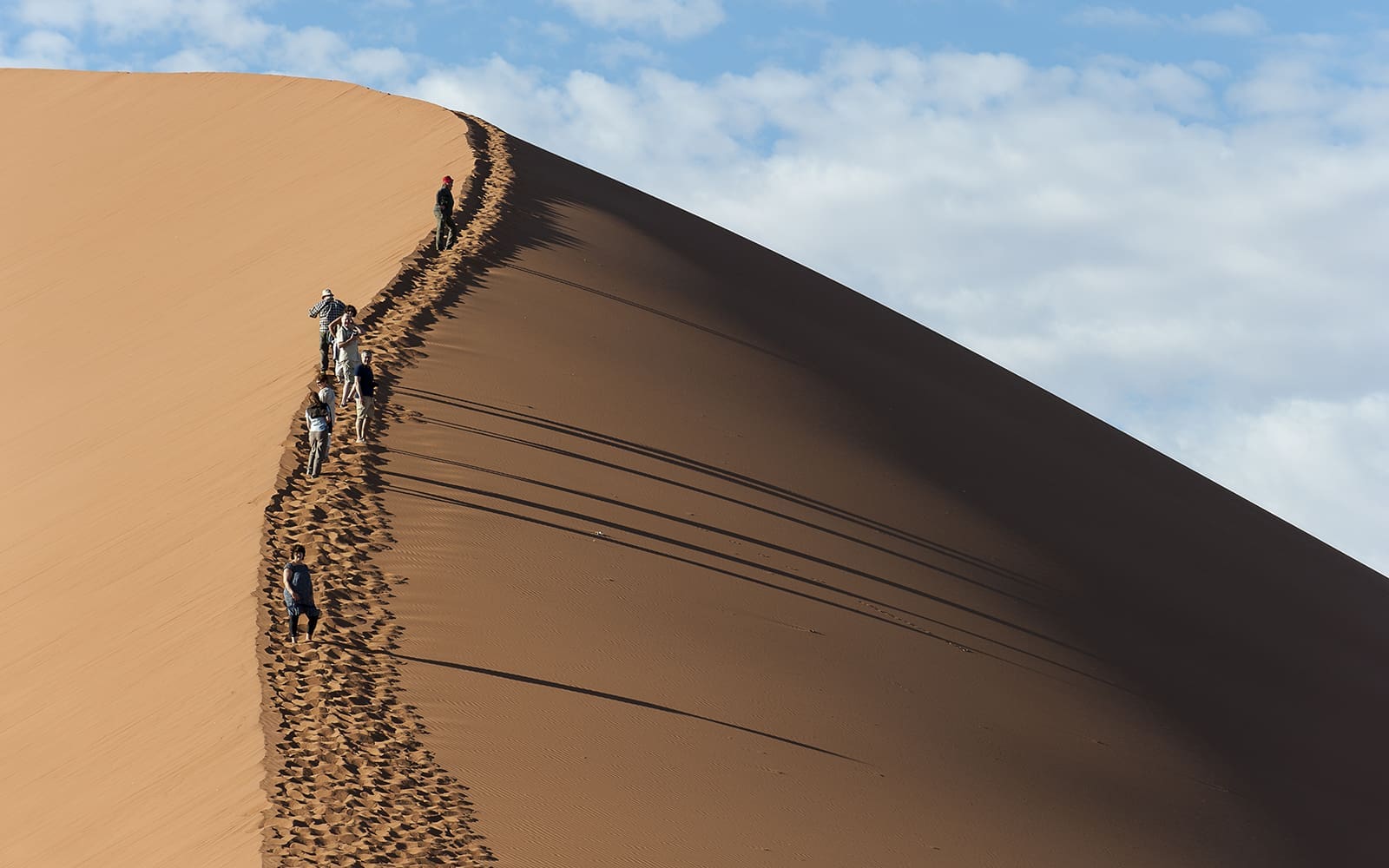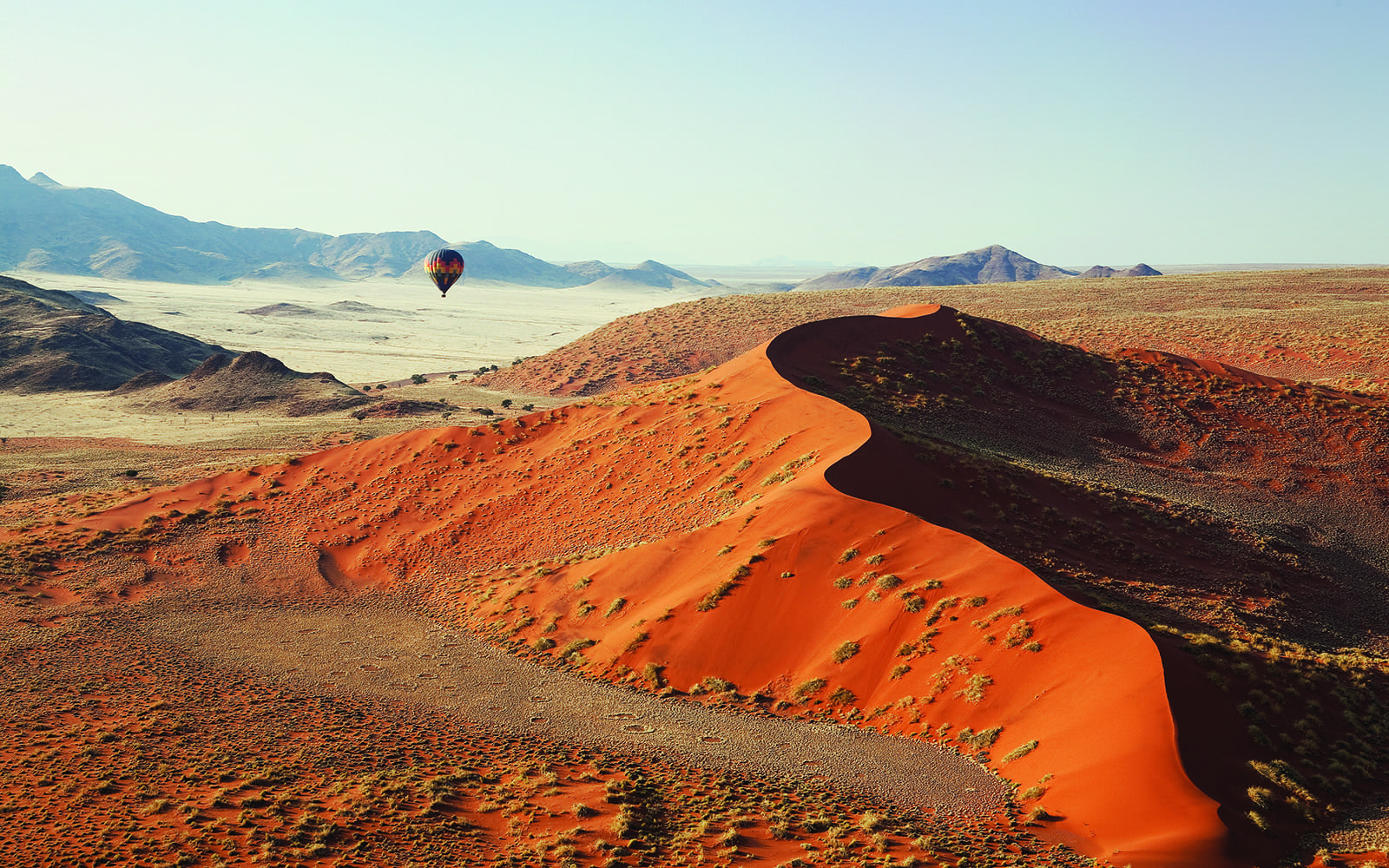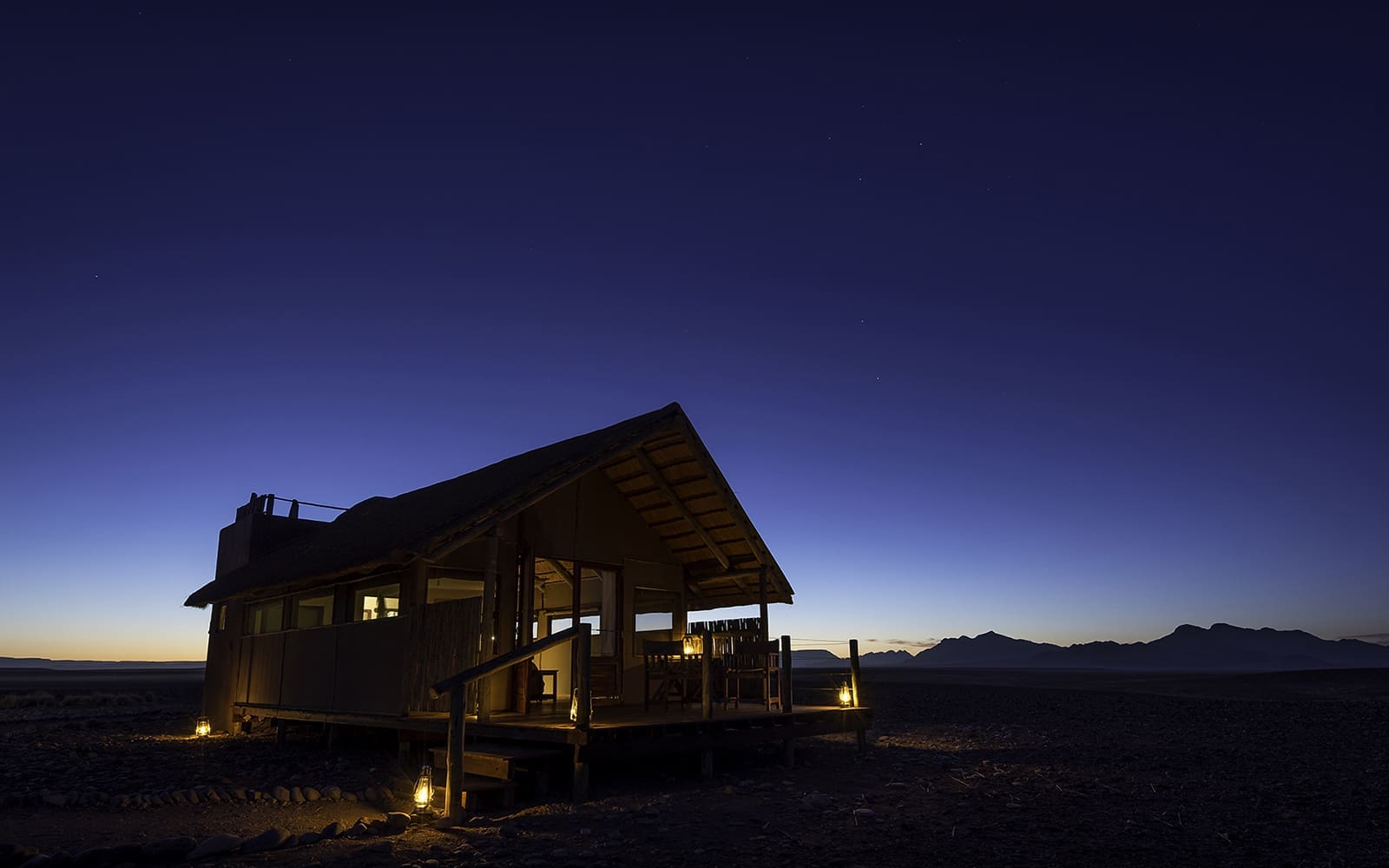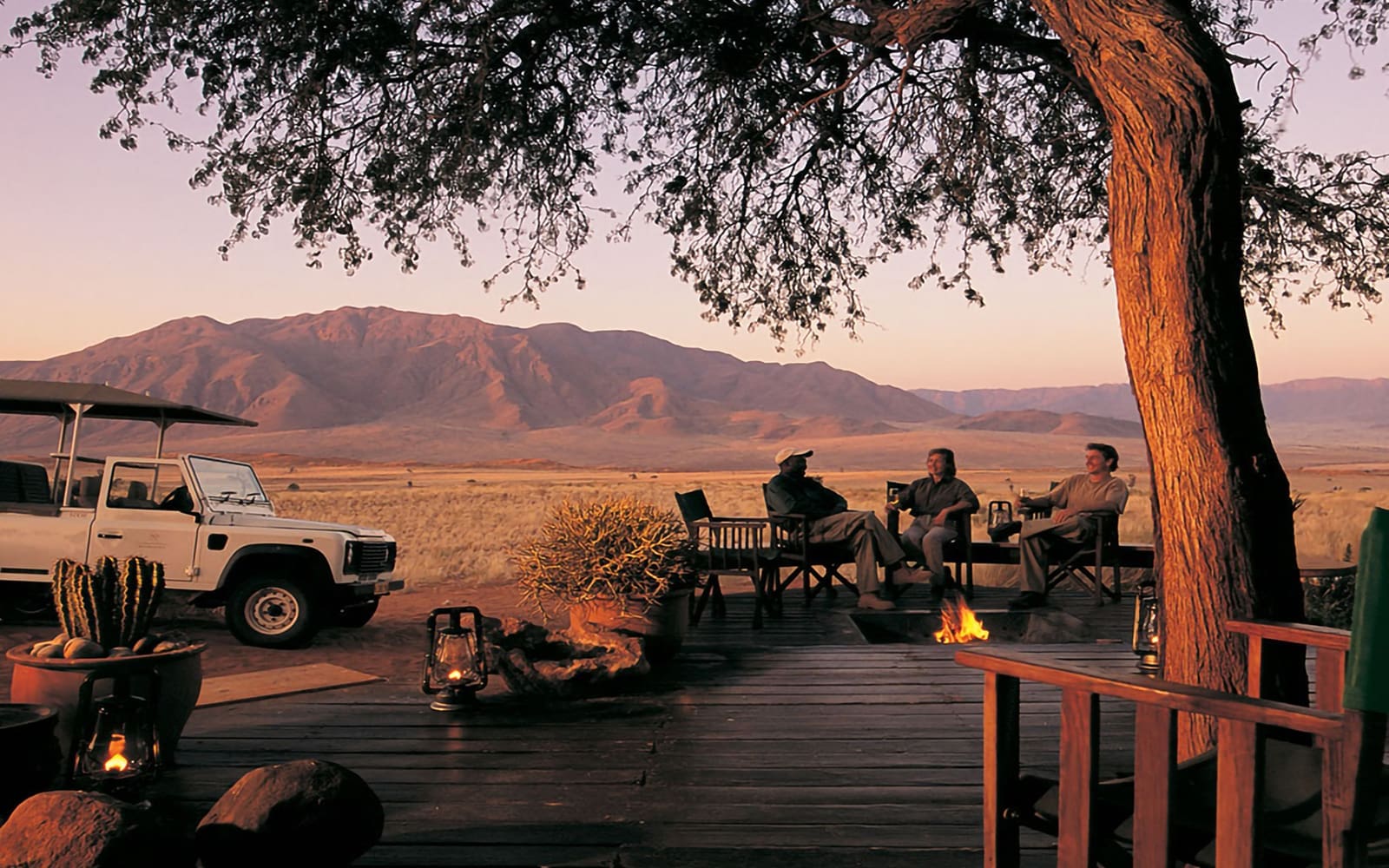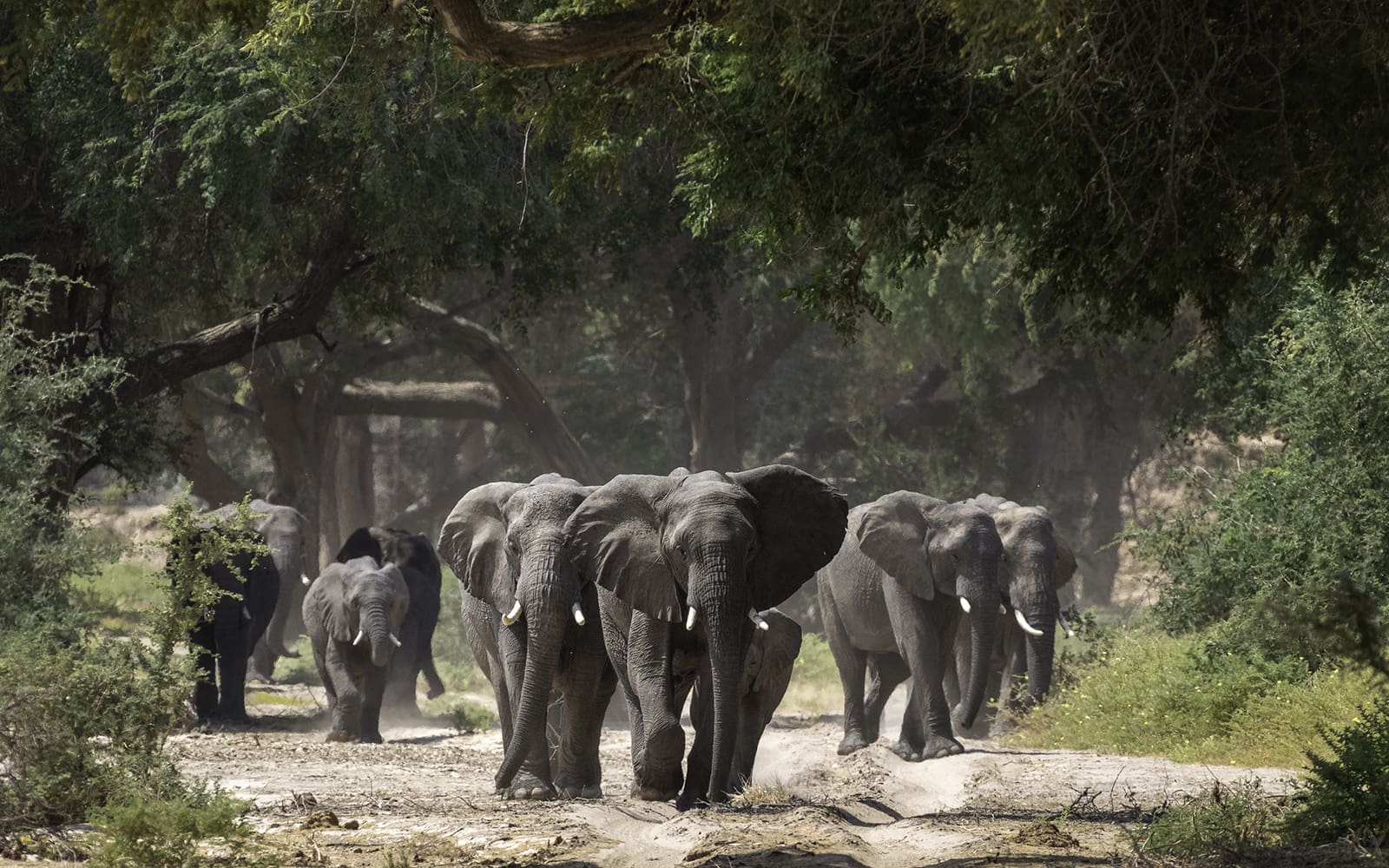Stay Longer, Stay Remoter: Namibia Safari
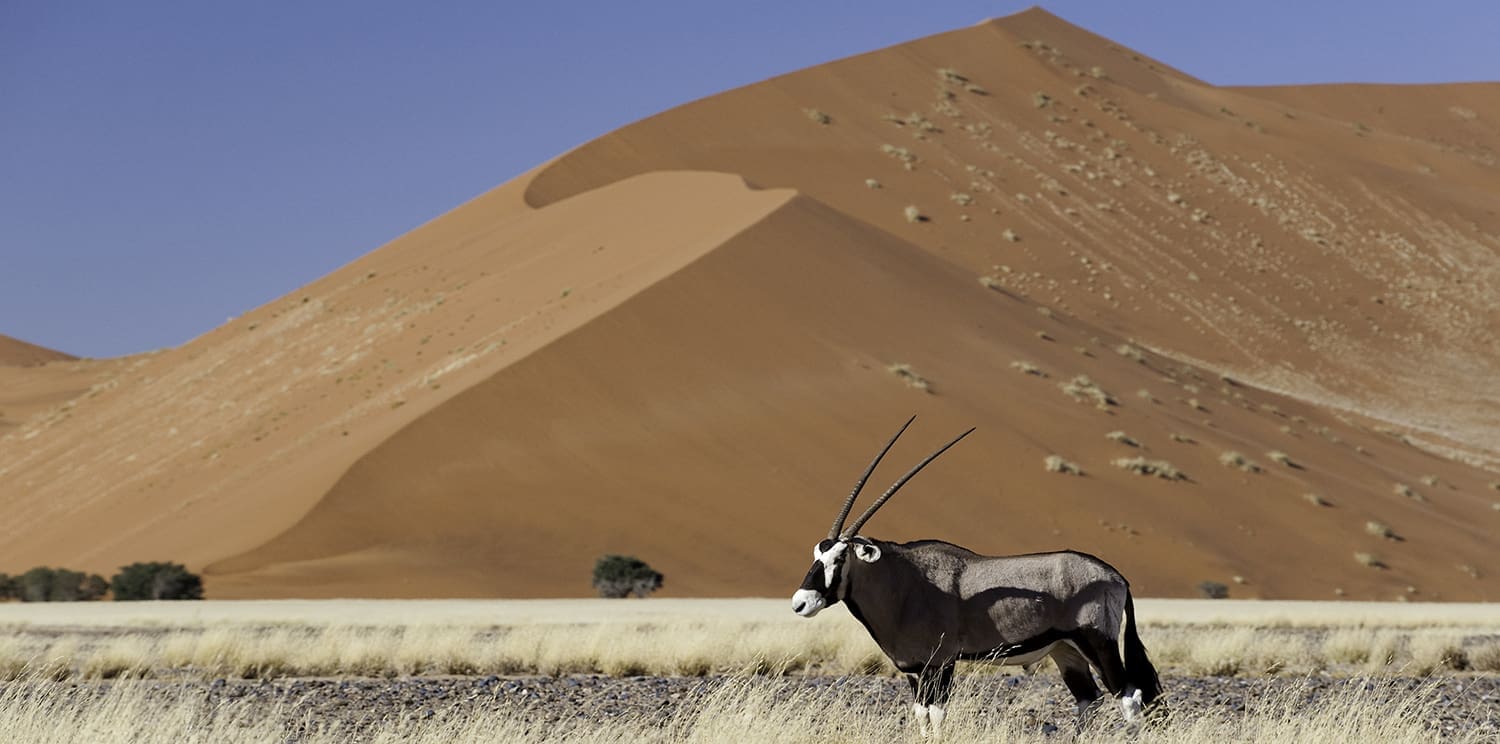

In terms of remoteness, a Namibia safari is quite possibly second to none. Within an area greater in size than Texas, only 2.7 million people reside in Namibia. In fact, Namibia is the second least densely populated country in the world! When leaving camp for activities, guests can go full days without seeing anyone else.
Namibia’s appeal, however, ultimately lies in its jaw-dropping, out of this world landscapes and the unique, desert-adapted wildlife that inhabit them. You could say there’s nowhere else on Earth like Namibia: from the starkly beautiful coastlines of Skeleton Coast to the monumental sand dunes of the Namib Desert, your time spent in Namibia will be unforgettable.
And you’ll want to stay as long as you can at each of these incredible destinations. From hot air ballooning in Sossusvlei, tracking desert-adapted rhinos on foot in Damaraland, to experiencing true solitude among the dunes and crashing waves of Skeleton Coast, there’s something for the adventurer in all of us on a Namibia safari!
Safari Destinations
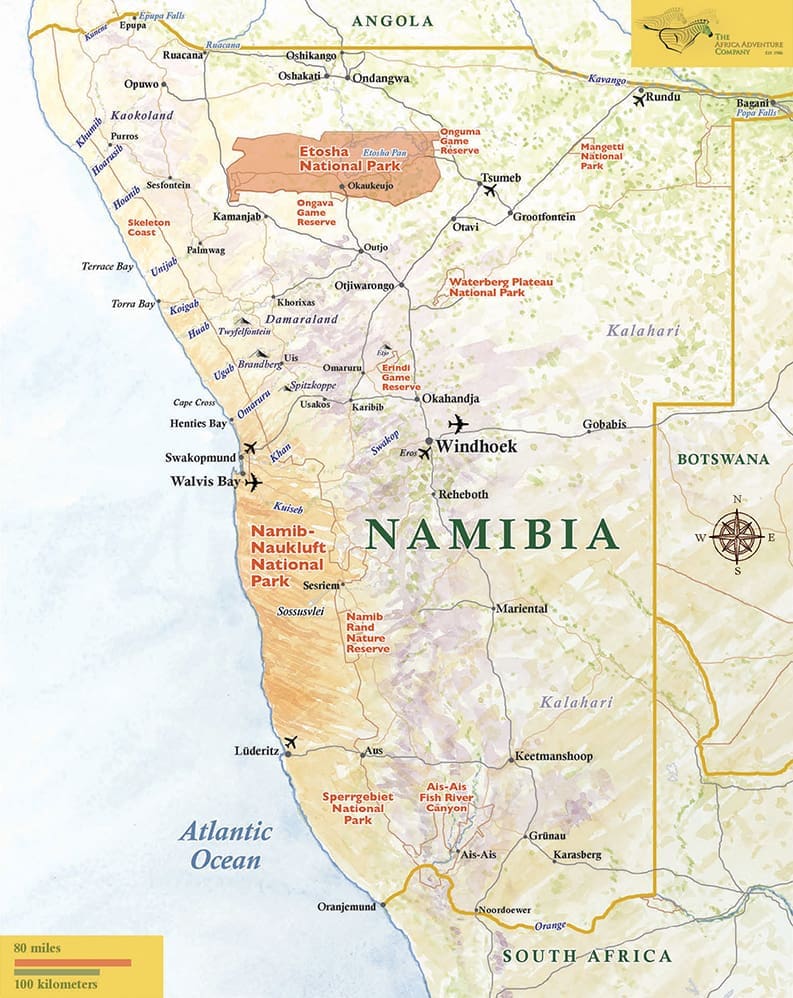

As mentioned before, Namibia is a large country. To save time on your Namibia safari, scheduled charter flights are the best way to get from one wildlife area to another. To save money, the best way to get around is by vehicle. An added bonus of the scheduled charter flights are the amazing aerial views they offer!
Each of these Namibian safari destinations can be characterized as “desert-like.” However, the no two destinations are the same. For instance, Skeleton Coast is undoubtedly a desert. However, the area around Etosha National Park has levels of rain more similar to the Okavango Delta in Northern Botswana.
Because of how fragile Namibia’s desert topsoil is, off-road driving is prohibited in both national parks and private reserves.
Joint Venture Conservancies are the presiding eco-tourism model in Namibia. This is where locals possess ownership of the land, receiving conservancy fees and employment opportunities from safari operators. Not only has this led to poverty alleviation in affected areas, it has also led to increased animal populations. One of the most notable accomplishments of this model is the recent return of lions to the Skeleton Coast.
Let’s begin our exploration of Namibia.
Namib Desert / Sossusvlei
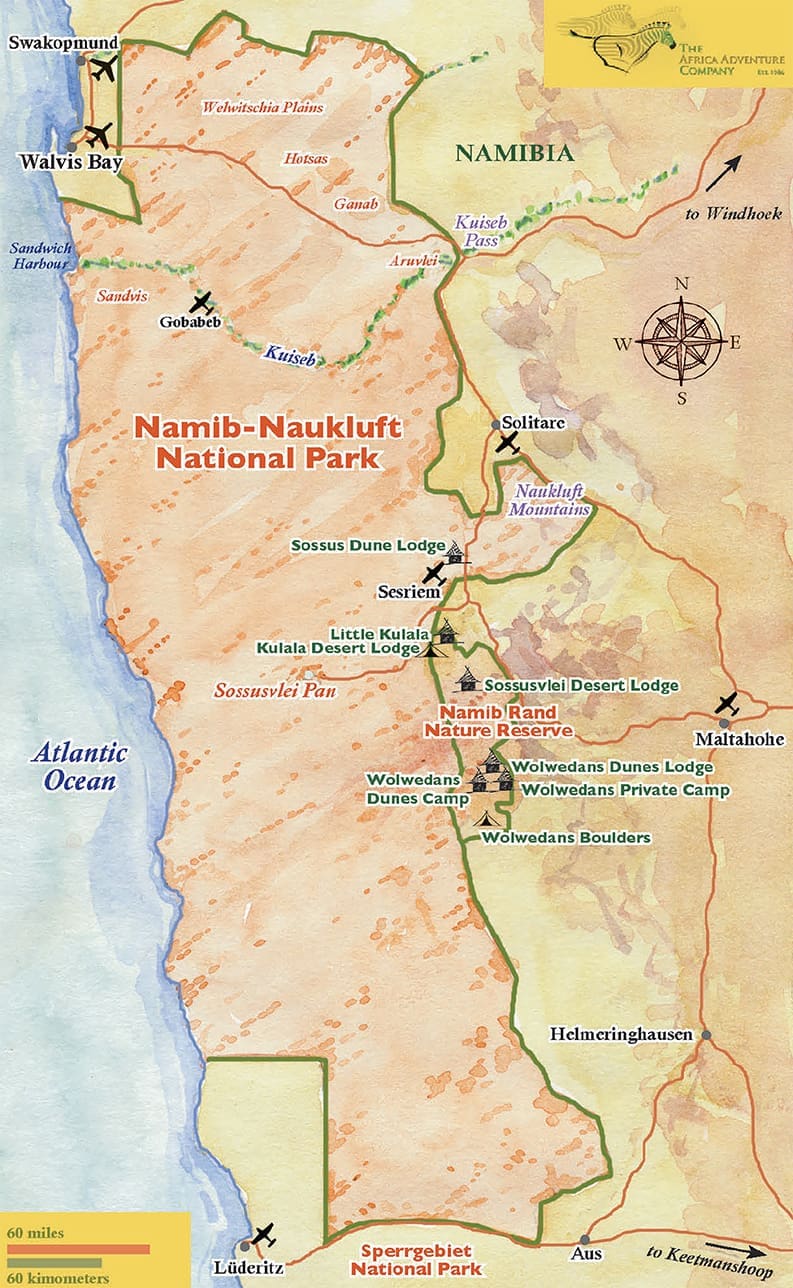

Cold, moist air sweeps from the Atlantic Ocean’s Benguela Current. Warm, dry air spreads from the inland deserts. When these two airs mix in the Namib Desert, condensation is created. This little bit of moisture is enough to sustain some of the world’s most fascinating flora and fauna.
The Namib Desert is most known for its towering, ocher-colored sand dunes (some of the world’s tallest) and its pans, like Sossusvlei and Deadvlei.


Deadvlei is a white pan, containg scattered, 800 year old “skeletons” of acacia trees
Sossusvlei is an expansive clay pan encircled by towering sand dunes. “Big Daddy,” the biggest in the area, is 1100 ft tall. Summiting Big Daddy requires a strenuous 60 to 90 minute hike. The view from the top overlooking the eerie Deadvlei makes this hike extremely worthwhile.


This part of the Namib Desert is most stunning at the break of dawn: the sunrise light up the dunes in beautiful, deep hues of red an orange. To experience this phenomenon requires an early-morning departure from a nearby camp or lodge. Two of the safari camps we list later can access Sossusvlei via their own private gate, allowing you to skip the notorious early-morning queues.


A flock of female ostriches in front of a sand dune (Credit: Alex Kostich, past AAC client)
Though the primary attraction of the Namib Desert is its stunning scenery, you should still be on the lookout for wildlife. You may find scattered hers of oryx (gemsbok), springbok, mountain zebra and ostrich. Your guide will also point out some fascinating small animals. The Palmato gecko, shovel-nosed lizard and the Namib golden mole are examples of some of the small animals you might have otherwise overlooked! Predators are also occasionally seen, including the elusive brown hyena.
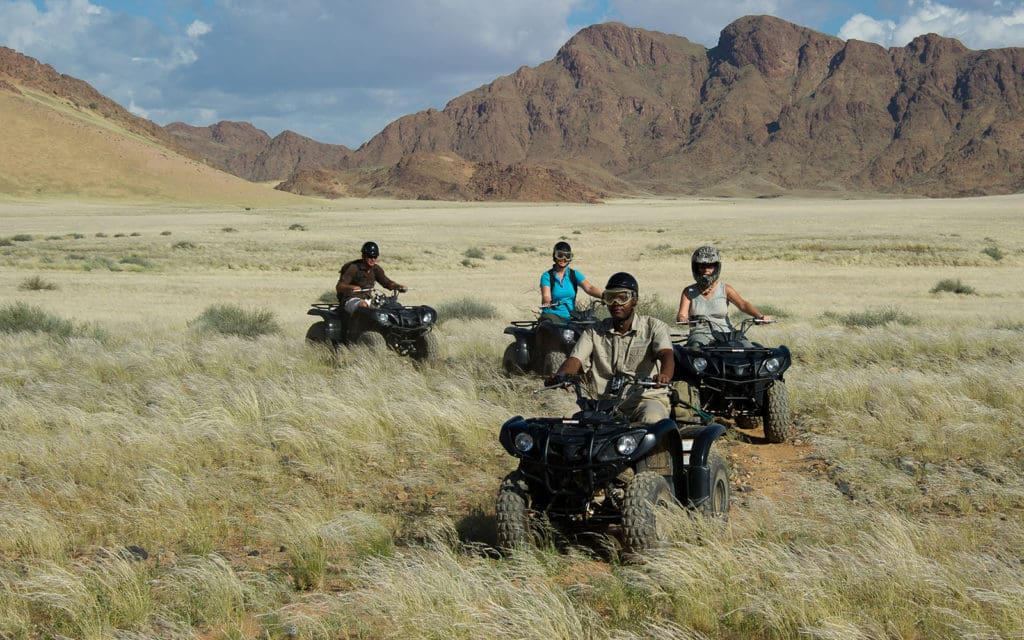

Quad-biking is one of many activities available during your stay in the Namib Desert
The Namib Desert offers a variety of activities, some of which are definitely adrenaline inducing! Check out our listed safari camps & lodges below to get a better understanding of the available activities.
Where to Stay: Little Kulala


The lounge at the newly refurbished Little Kulala
- Location: near entrance to Namib-Naukluft National Park
- # of Rooms: 11 thatch-and-canvas Tented Chalets
- Available Activities: Game Drives; Night Drives; Scenic Hikes; Biking; Starbed sleep-out; Pool; Hot Air Balloon Rides; Quad-Biking; Spa
After a recent refurbishment, Little Kulala is undeniably stunning. The new camp’s aesthetic takes inspiration from Deadvlei. The floor-to-ceiling windows and spacious verandahs (plunge pool included) will allow guests to take in the stunning, open vistas surrounding the camp. In addition, the internal climate control will be helpful during those toasty afternoons and chilly mornings.
Where to Stay: Kulala Desert Lodge
- Location: near entrance to Namib-Naukluft National Park
- # of Rooms: 23 thatch-and-canvas Tents (including 3 family tents)
- Available Activities: Game Drives; Night Drives; Scenic Hikes; Biking; Starbed sleep-out; Pool; Hot Air Balloon Rides
For those eager to visit Sossusvlei as early as possible, Kulala Desert Lodge’s close proximity to a private entrance gate makes it a great choice. Each of the thatch-and-canvas tents are on an elevated wooden platform, which also includes a private verandah. Guests who want to sleepout under the stars merely have to climb the stairs to the to the top of their tent.
Where to Stay: Wolwedans Dune Camp
- Location: Namib Rand Reserve
- # of Rooms: 6 Tents
- Available Activities: Game Drives; Scenic Hikes; San (bushmen) Walks; e-Biking; Village Tour; Horseback Riding; “Solitude” meditation; Spa; Starbed sleep-out; Pool; Hot Air Balloon Rides; Scenic Flights
Wolwedans Dune Camp is arguably the most remote of the safari accommodations in the Namib Desert region. This intimate camp has six comfortable tents built on wooden platforms. Each tent has enough decking to allow for sleeping out under the stars. An added bonus for astronomy enthusiasts: the Namib Rand Reserve is the only International Dark Sky Reserve in all of Africa.
Damaraland
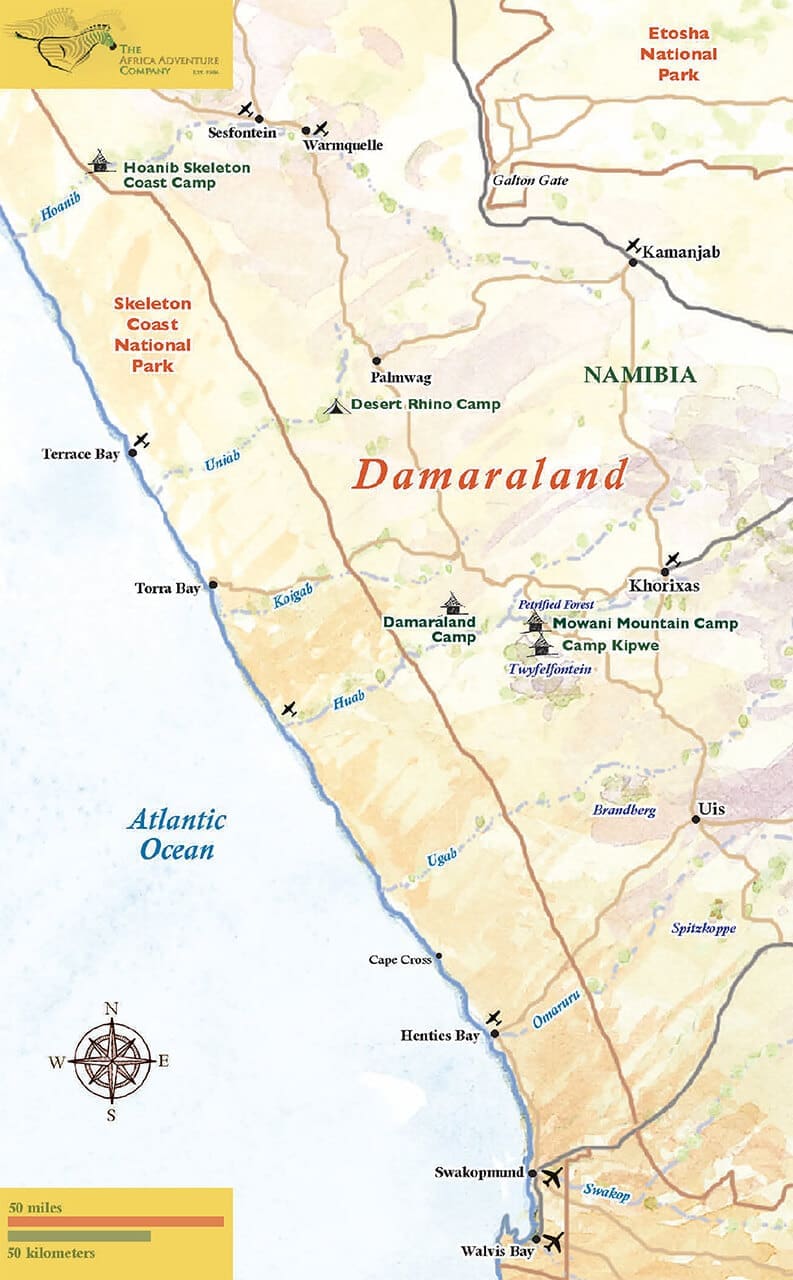

Damaraland is neither a national park nor a private reserve. Rather, this region is comprised of a tapestry of Joint Venture Conservancies. This model allows wildlife and livestock, tourism and locals to live side by side. For many villages in the region, the conservancy fees and employment in the tourism industry has also been a key factor in poverty alleviation.
Damaraland is an arid, rugged landscape, with a patchwork of rock-strewn mountains and open, barren plains. In the distant past, there was much volcanic activity. The most apparent legacy of this past is the Petrified Forest; flowing lava engulfed numerous large trees, turning them into “stone.” But because of the various ephemeral rivers, springs and oases, there are dispersed concentrations of vegetation. So wildlife does concentrate in surprisingly high numbers here.
The video above was captured with a GoPro. It demonstrates how, despite their immense size, quiet a her of desert-adapted elephants can be when on the move.
The megafauna that do reside in Damaraland are unique in that they are desert-adapted. For example, elephants here have larger feet than elsewhere in Africa; the theory is that this allows them to better trudge through the sandy terrain. Other megafauna species include black rhino, lion, cheetah and even leopard.
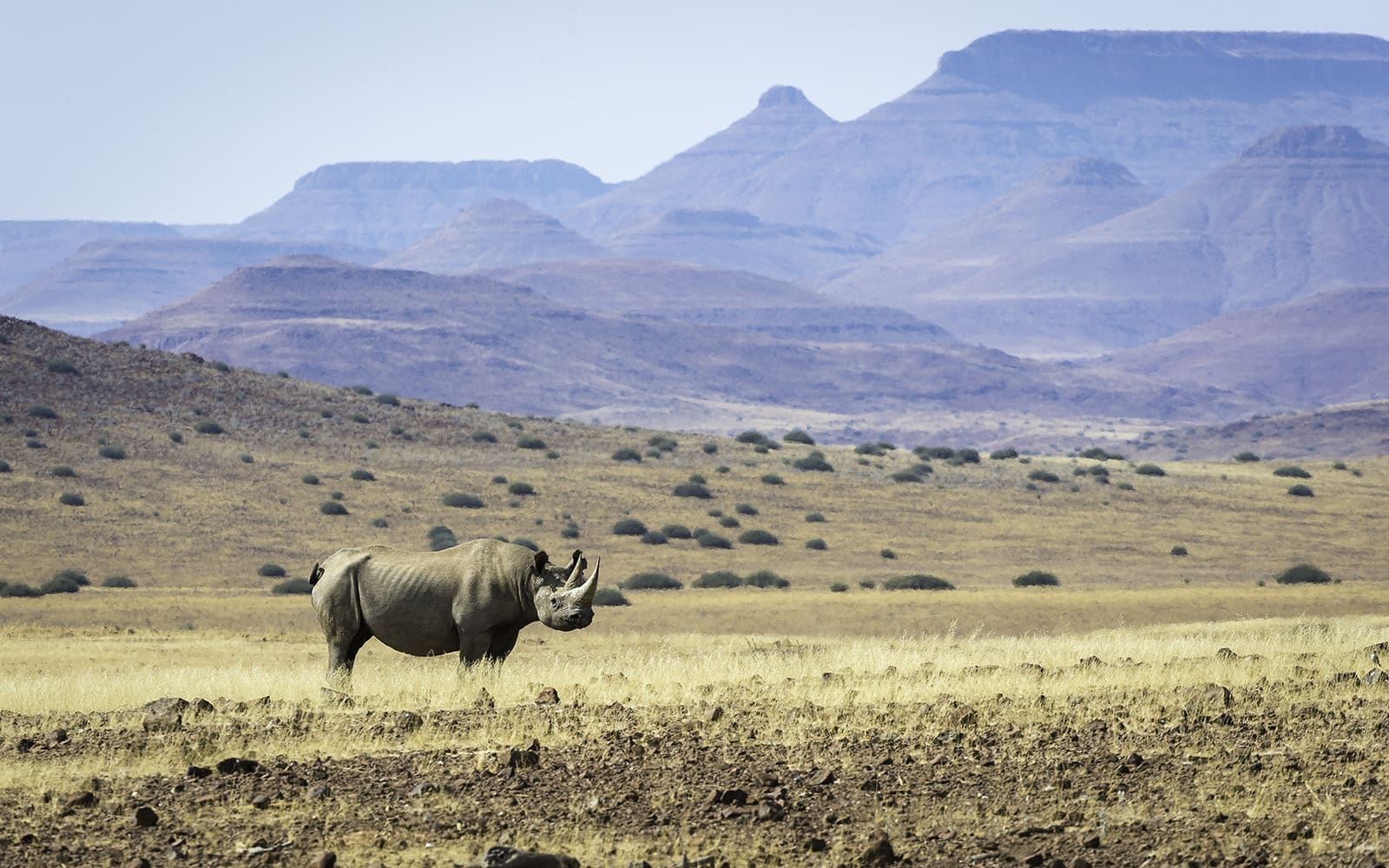

Guests staying at Desert Rhino Camp can go on thrilling walking safari to see black rhino
A unique way to view the region’s wildlife is a visit to Twyfelfontein, whose sandstones serve as canvases to one of Africa’s largest concentration of ancient petroglyphs (rock engravings). Some of these petroglyphs by the San (bushmen) are over 2000 years old, and include wildlife, humans as well as spore. Due to its remote location, a visit to Twyfelfontein requires a whole day.
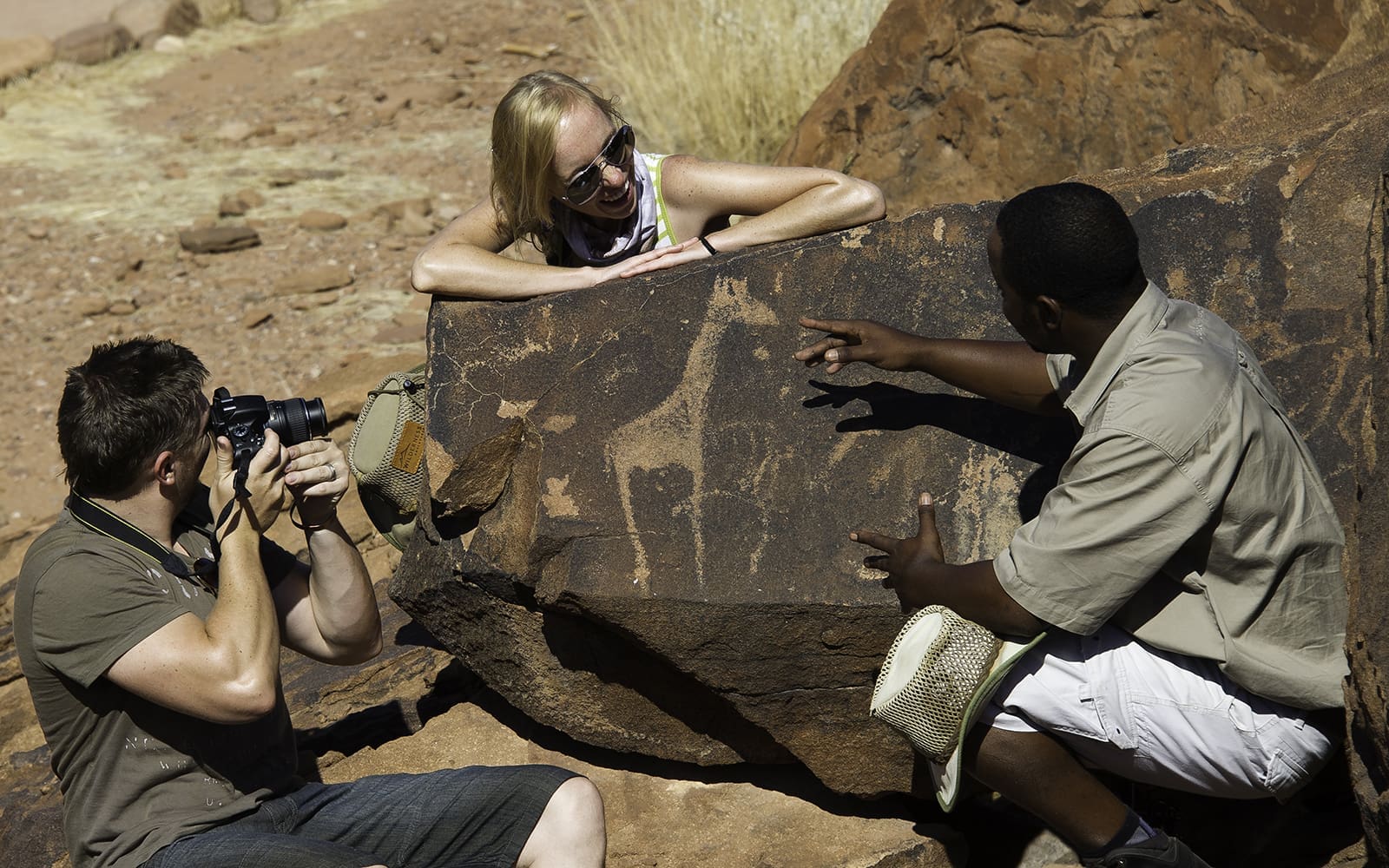

One of the many petroglyphs at Twyfelfontein, a UNESCO World Heritage Site
For guests interested in learning about the Joint Venture Conservancies, village visits can be arranged. Other than hikes and game drives, most other activities vary by camp.
Where to Stay: Doro Nawas
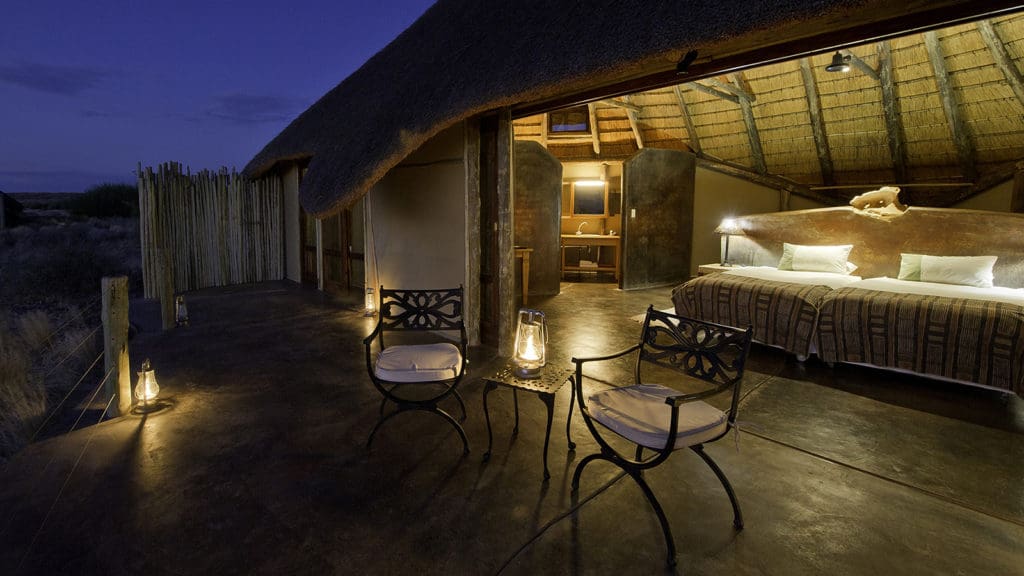

Exterior of one of the thatched suites
- Location: near Petrified Forest & Twyfelfontein
- # of Rooms: 16 thatched Suites (including 1 family unit)
- Available Activities: Game Drives; Night Drives; Scenic Hikes; Village Tour; Starbed sleep-out; Pool; Visit Twyfelfontein
For guests wanting to explore the Petrified Forest and Twyfelfontein, Doro Nawas is an excellent base of operations. This area also has a high concentration of desert-adapted elephant.
Where to Stay: Desert Rhino Camp
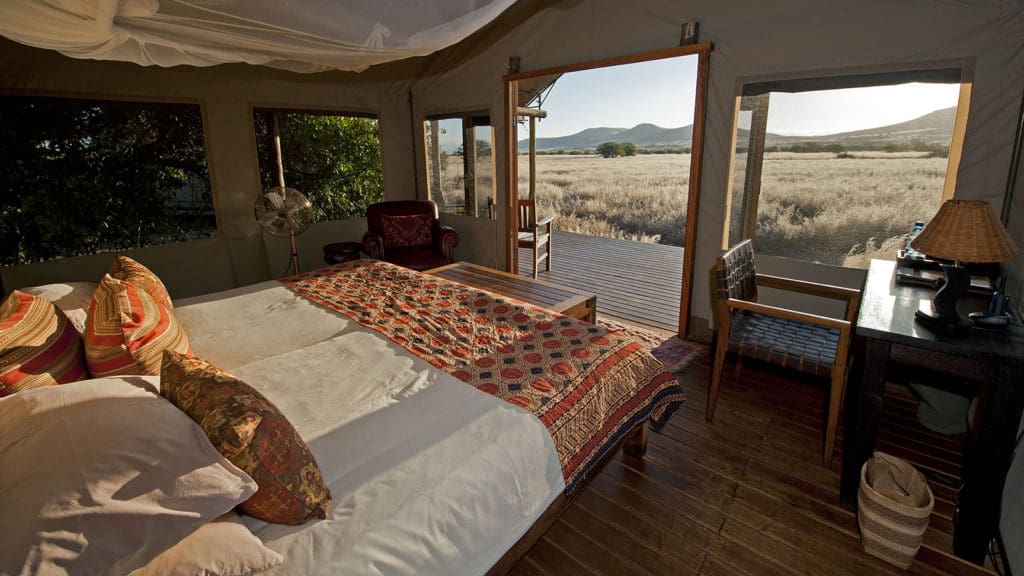

Looking out from one of Desert Rhino Camp’s Meru-styled tents
- Location: Palmwag Concession
- # of Rooms: 8 Meru-styled Tents (including 1 family unit)
- Available Activities: Game Drives; Scenic Hikes; Pool; Rhino Tracking on Foot
As the name implies, the defining experience of Desert Rhino Camp is to see black rhino, both on game drives and by foot. This rustic camp is located in the furthest north of Damaraland, requiring an additional charter flight to access. But trust us – it’s worth it.
Where to Stay: Camp Kipwe
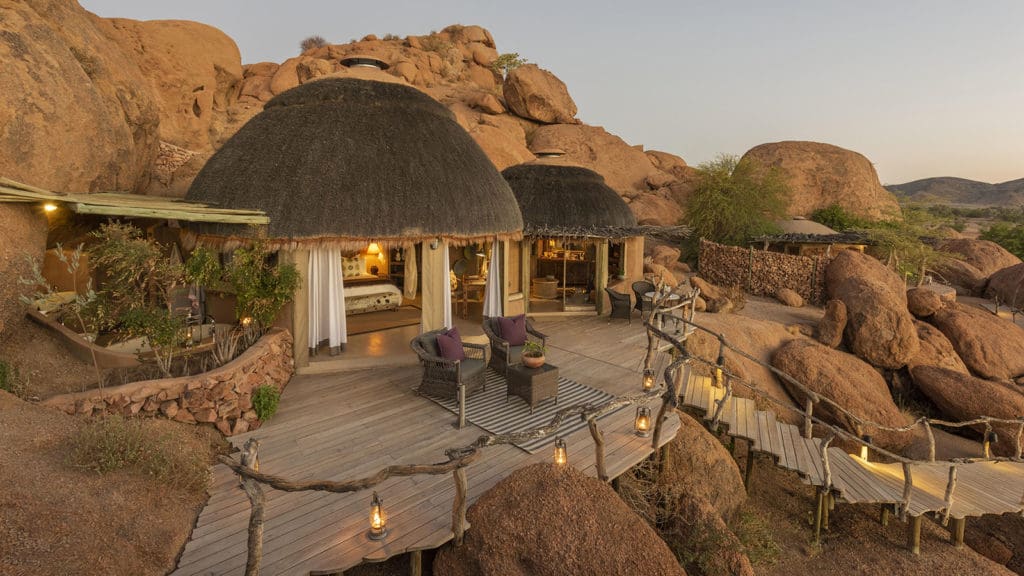

Camp Kipwe is situated among granite kopjes
- Location: near Petrified Forest & Twyfelfontein
- # of Rooms: 10 Thatched Bungalows (Including 1 double)
- Available Activities: Game Drives; Scenic Hikes; Pool; Visit Twyfelfontein
Camp Kipwe has all the advantages that Doro Nawas has, but with an added bonus: it’s setting, among large granite rocks, offers great views of the surrounding plains!
Skeleton Coast & Kaokoland
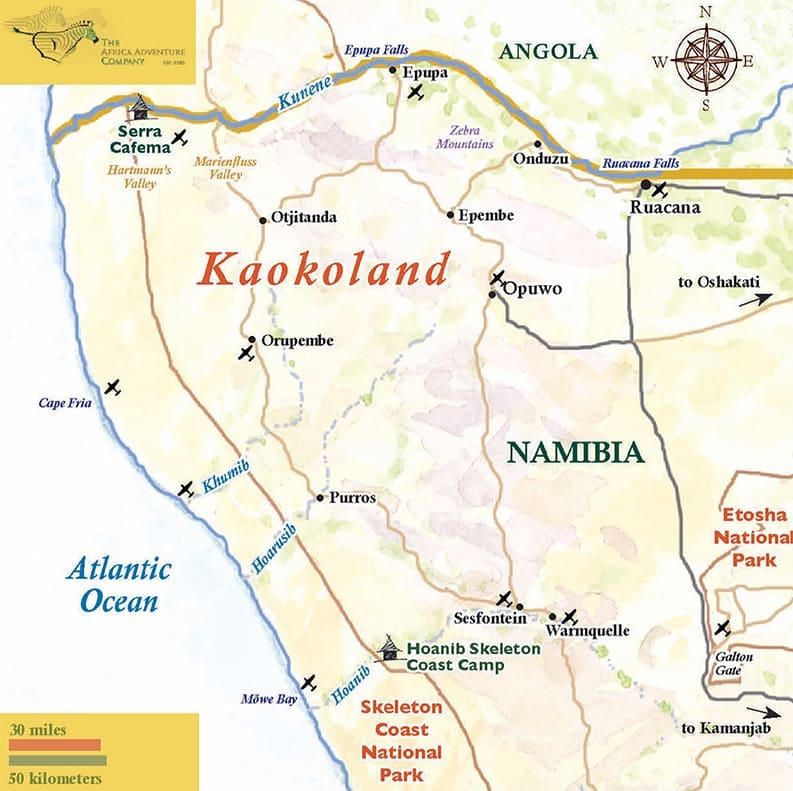

Skeleton Coast is arguably Namibia’s most iconic destination. Thick fog blankets the coastline until the late morning. As AAC Safari Consultant Szilvia Hegyi said during her safari to Namibia May 2019, the flight over the harshly beautiful Skeleton Coast “was the most breathtakingly spectacular plane ride I’ve ever been on.”
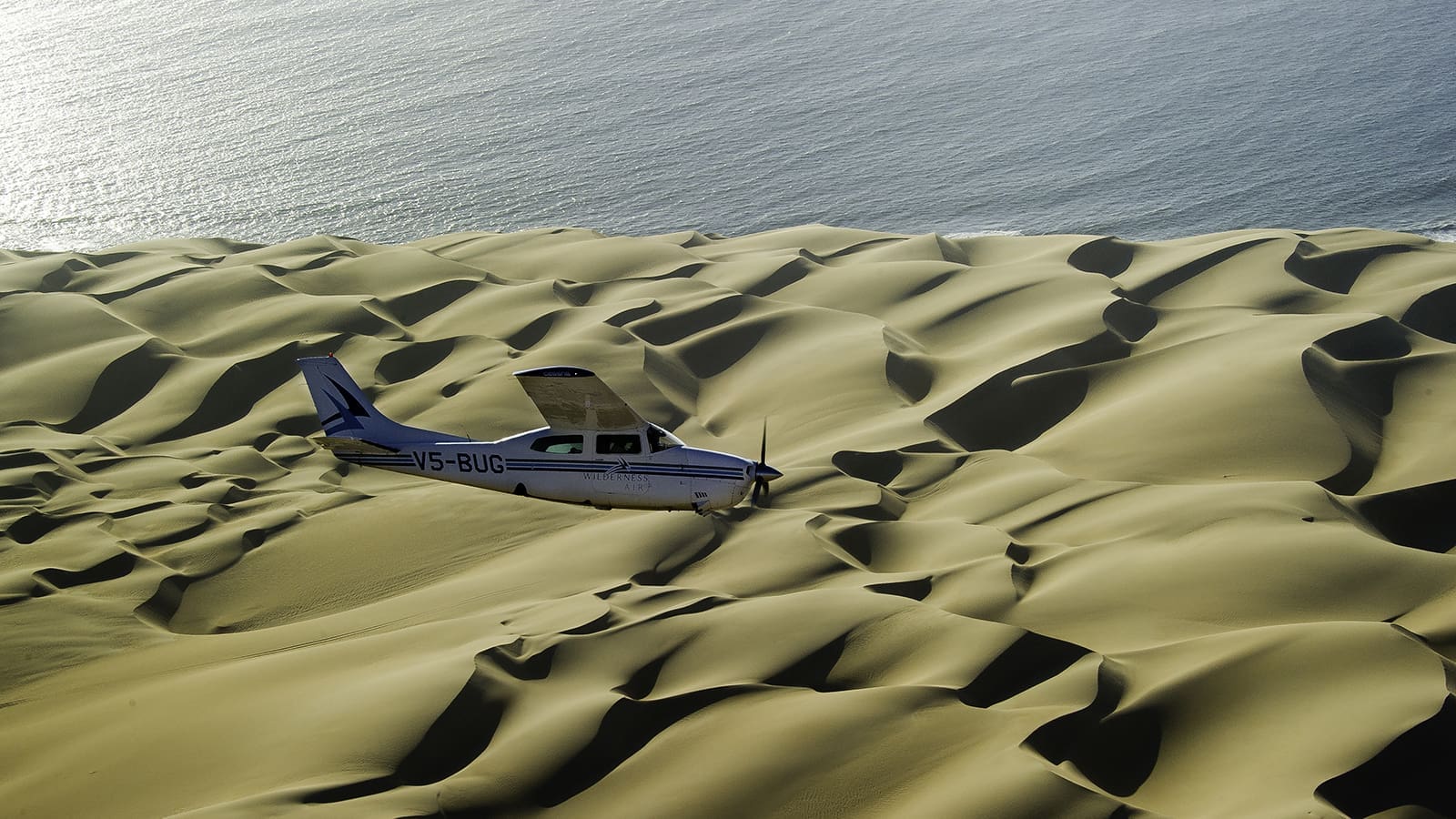

We highly suggest flying to visit Skeleton Coast; not only will you save time, but you will have unreal views of the coastline
This is perhaps the single most remote region for a Namibia safari. And as a result, it is remarkably pristine, with a very small tourism presence. Because of its remoteness, flying is highly recommended.
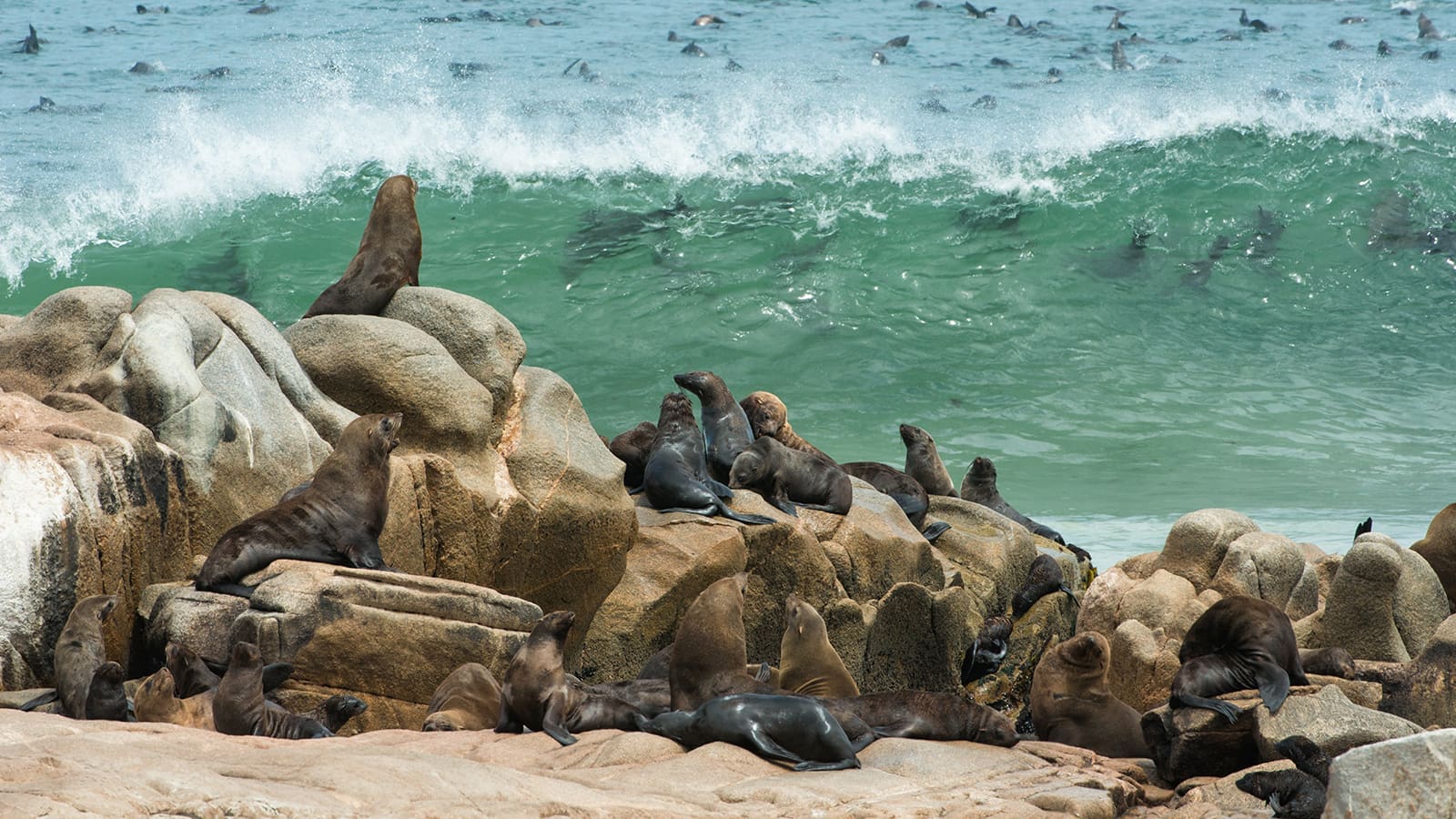

One of the many Cape fur seal colonies along the Skeleton Coast
Like Damaraland, this region of Namibia is also home to a slew of desert-adapted wildlife. But there are several unique additions, like the Cape Fur seals, brown hyena and cheetah.
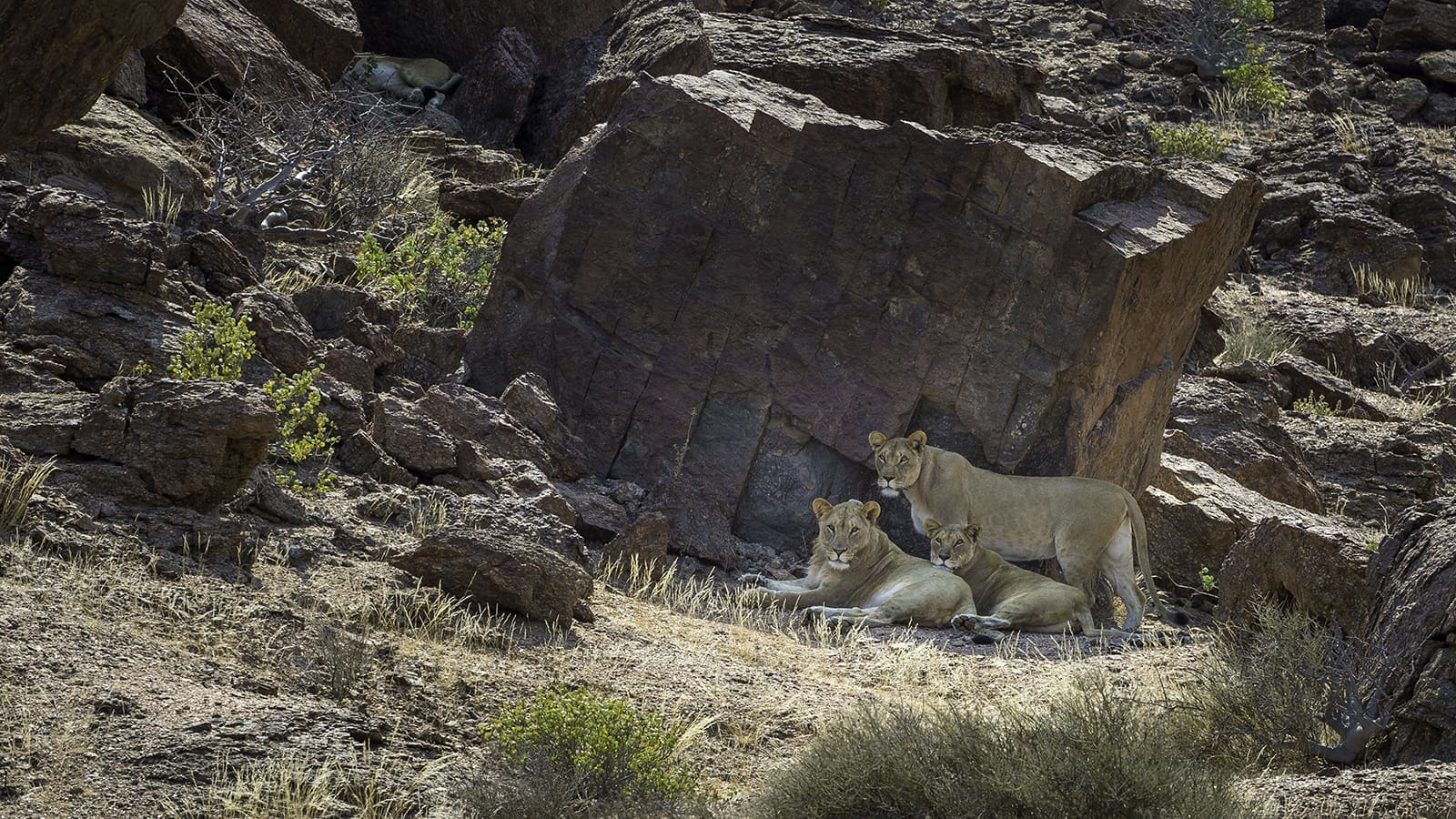

Thanks to the work of researchers like Dr. Flip Stander, Skeleton Coast’s lion population has undergone a major resurgence
The wildlife experience at Skeleton Coast is amplified by guests’ access to researchers, including Emsie Verwey of the Brown Hyena Project and Dr. Flip Stander of the Desert Lion Conservation Project. Guest of ours remark that they were able to casually sit around their camp’s fireplace (with a glass of wine in hand!) before dinner and chat with these researchers about their essential conservation work.
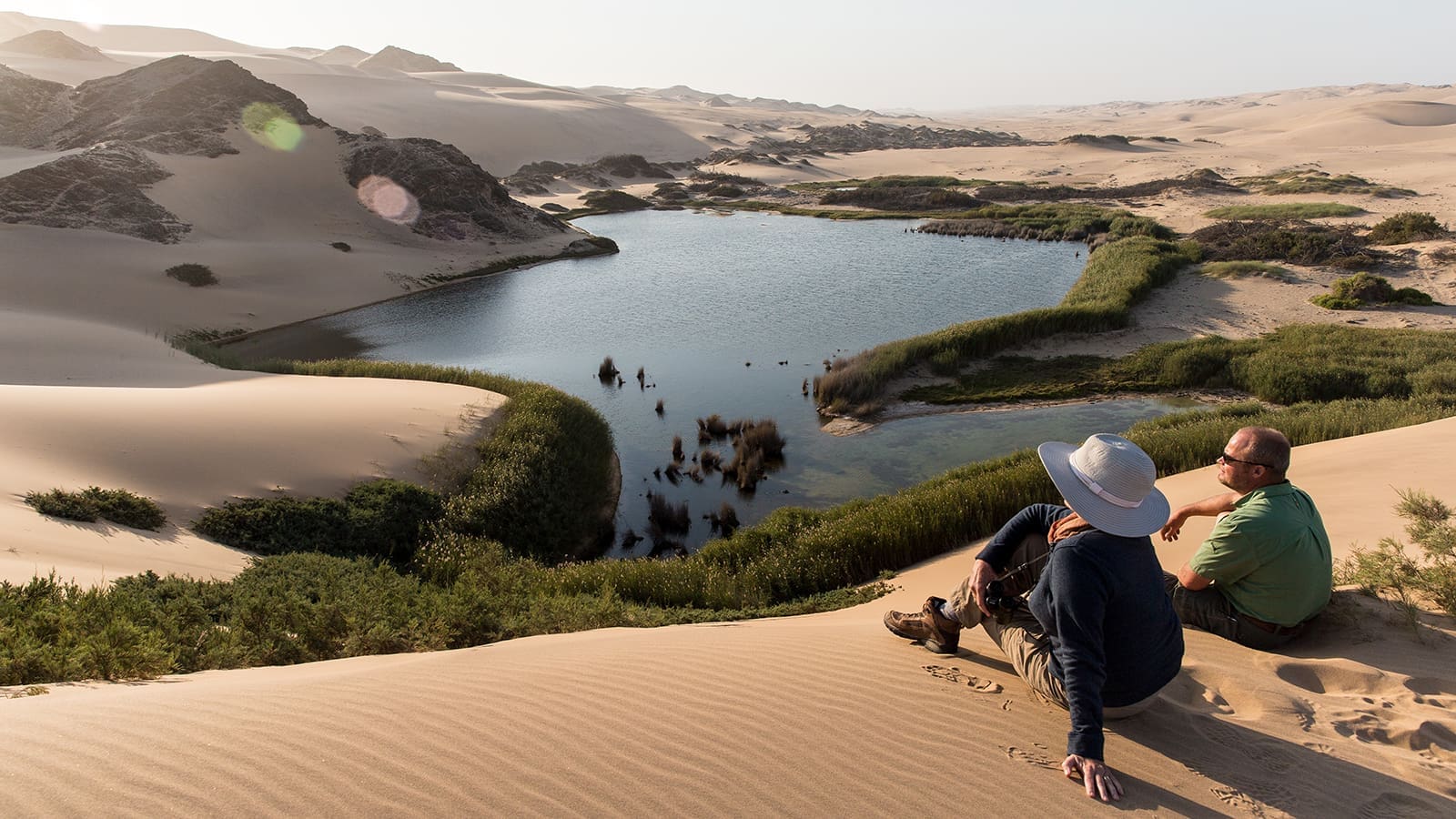

The ephemeral rivers and oases of the Hoanib Valley strikingly contrast with the sand dunes
Most camps are located near the boundary of the Skeleton Coast National Park. So activities are split between day trips into the park and game viewing among the inland rivers and oases. In the park, visitors can visit the massive seal colonies and find the rusted, “skeletal” remains of several ships. If you’re lucky you may also spot the rare brown hyena – camping on the coastline like Szilvia Hegyi did will up your chances!
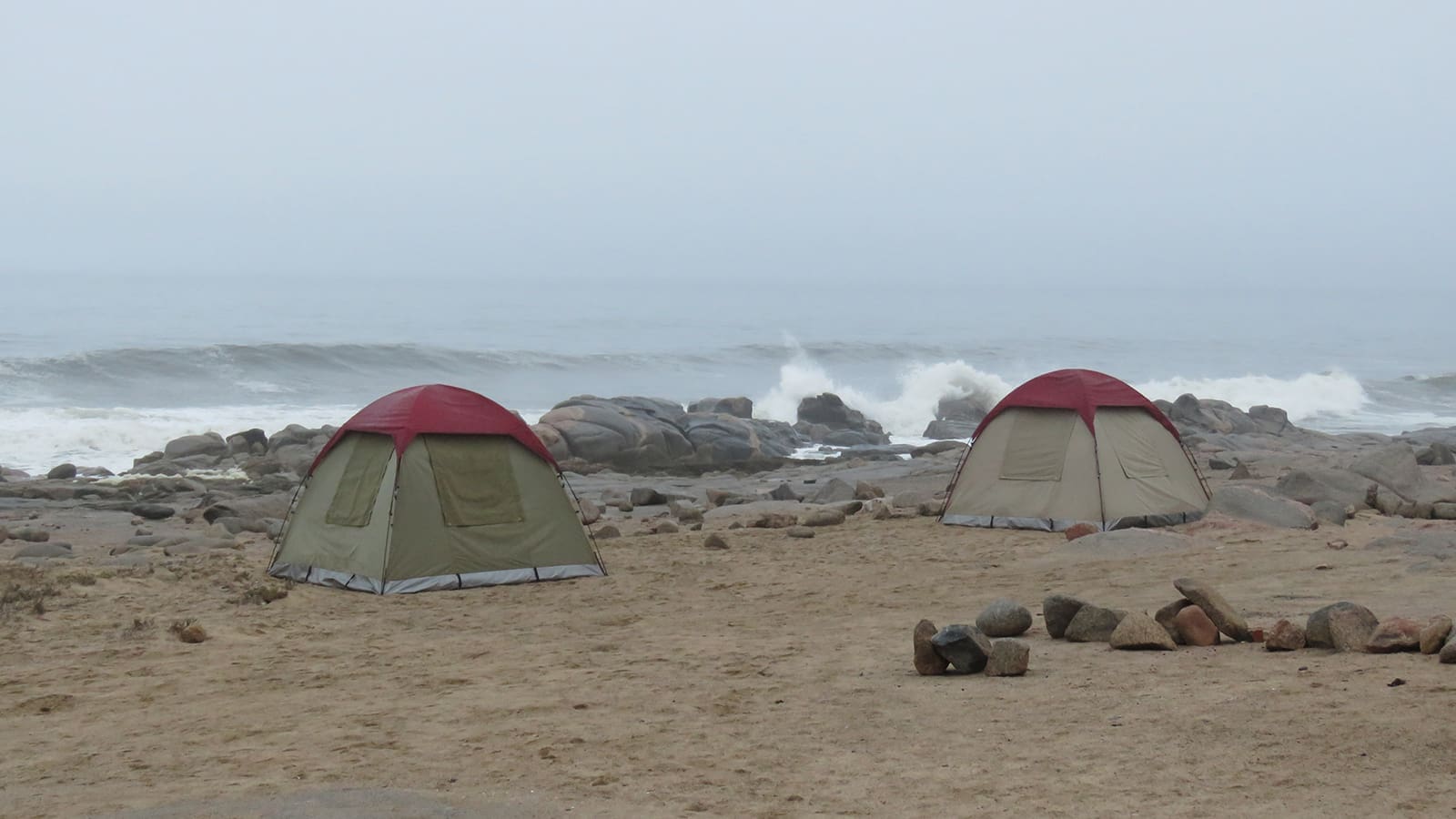

More intrepid safariers can fly-camp right on the coastline – just as AAC Safari Consultant Szilvia Hegyi did!
Game drives and scenic walks are available at most camps. For those wanting an authentic cultural experience, the far north of Skeleton Coast in the Kaokoland region is home to the semi-nomadic Himba. The Himba are most recognized by the ocher-colored paste they cover their body with – both a traditional culture practice and a pragmatic solution to the region’s unforgiving sun.
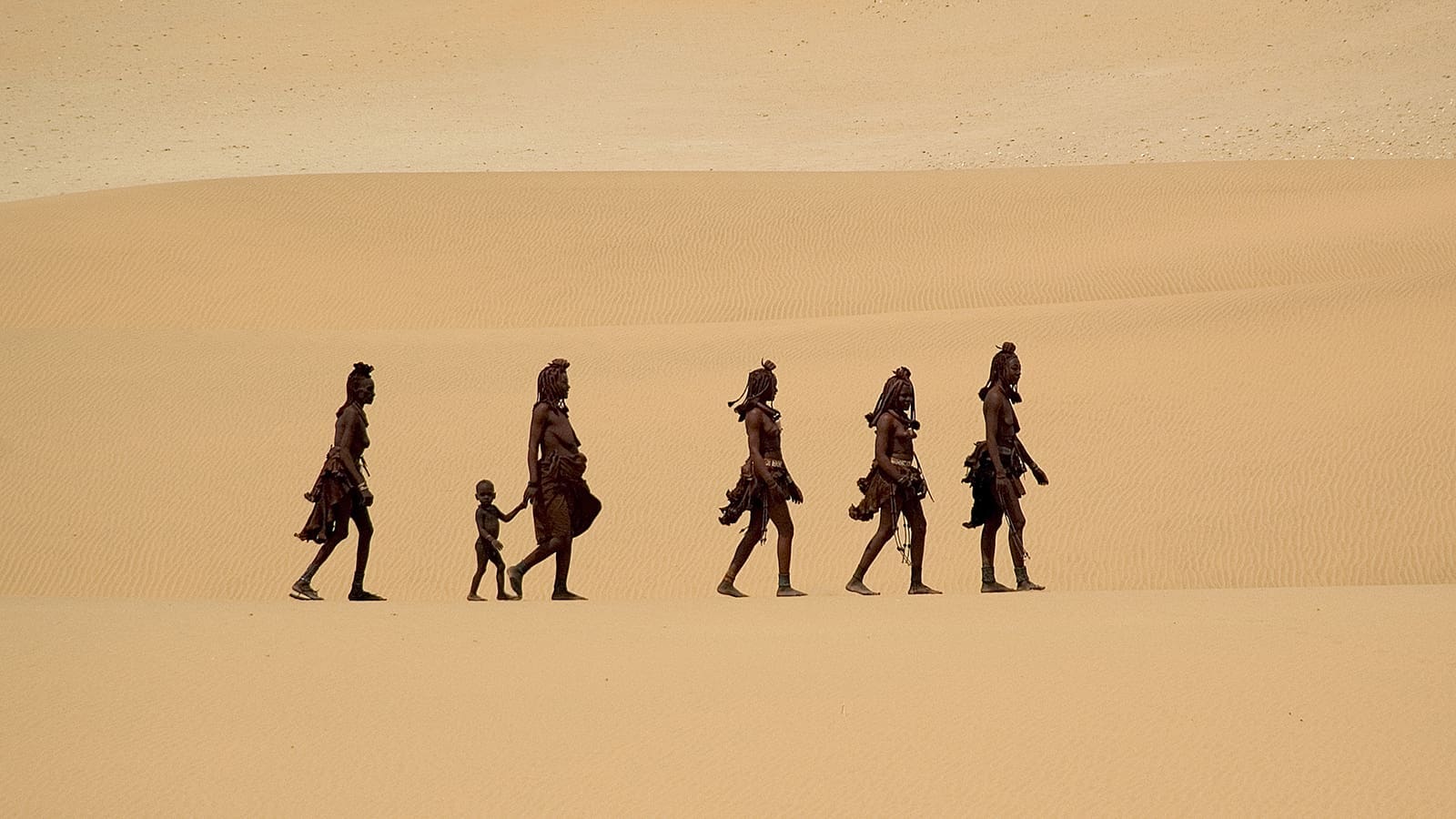

Serra Cafema offers an accessible, and respectful, opportunity to visit the local Himba
If you visit Kaokoland, you can go quad-biking and even boating on the Kunene River, like Szilvia did! Boating offers great game viewing chances, birdwatching, and of course, the customary safari sundowner!
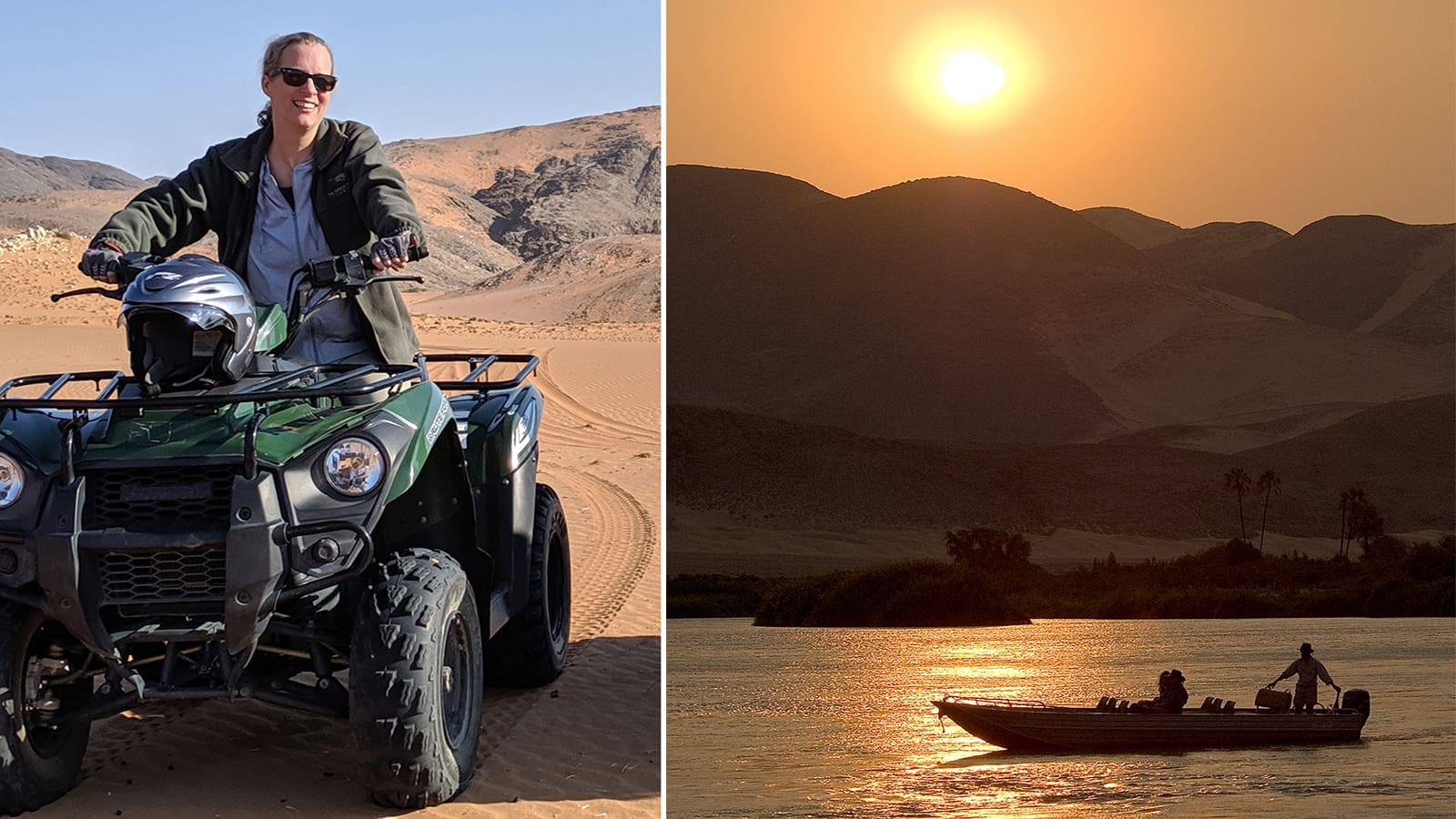

(R) Szilvia taking a break form a busy morning of quad-biking; (R) guests at Serra Cafema should consider a boating safari
Where to Stay: Hoanib Skeleton Coast
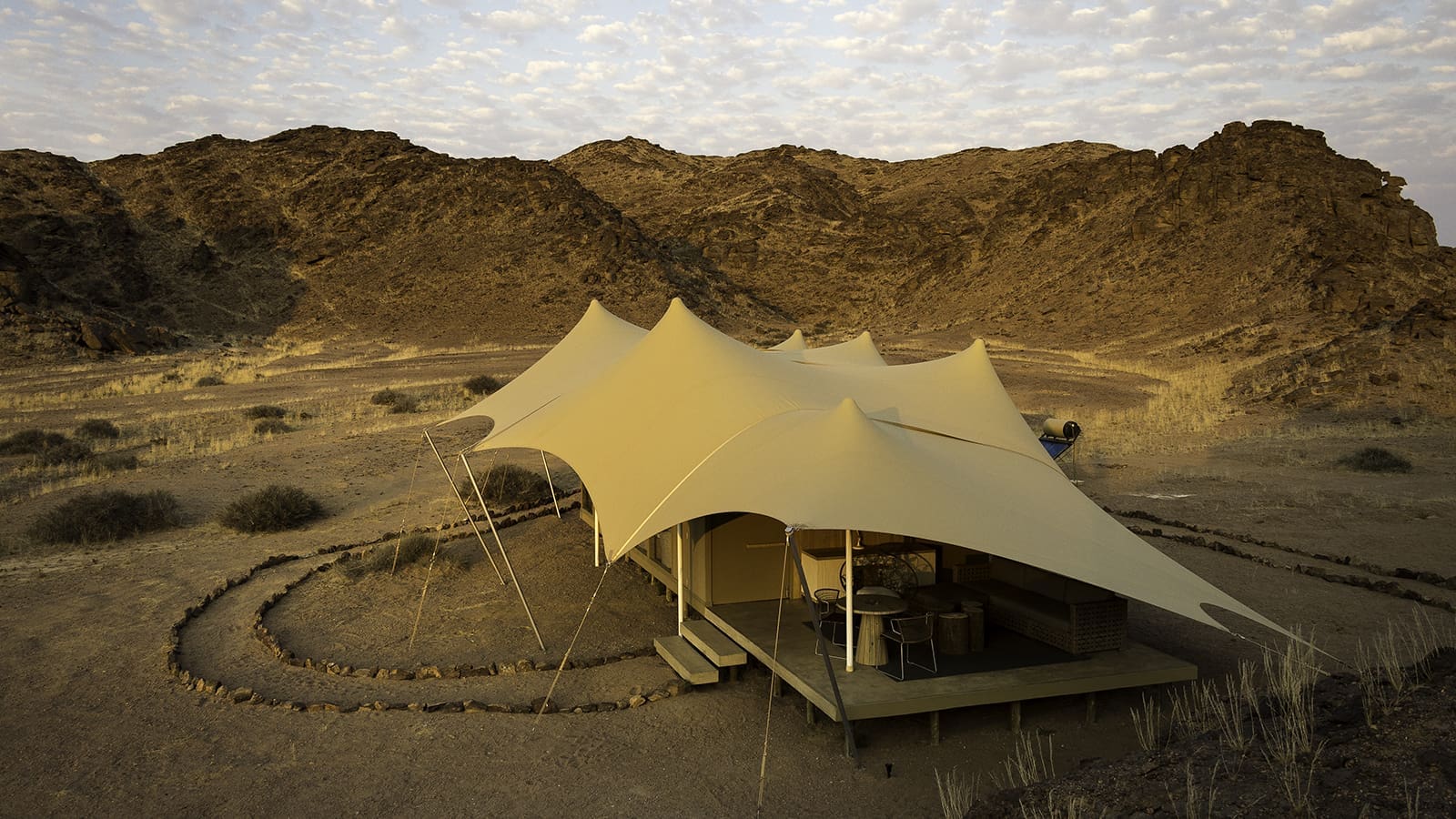

- Location: Palmwag Concession
- # of Rooms: 8 Luxury Tents (Including 1 family unit)
- Available Activities: Game Drives; Scenic Hikes; Pool; Day-Trips to Skeleton Coast; Meet with Wildlife Researchers
This remote camp provides guests with a near exclusive experience of the Hoanib riverbed and the Skeleton Coast coastline. The aesthetic at Hoanib Skeleton Coast is more contemporary, where the hues of white, tan and blue mimic the nearby Skeleton Coast coastline. Besides having some very talented guides, there are some incredibly knowledgeable wildlife researchers on site as well.
Where to Stay: Serra Cafema
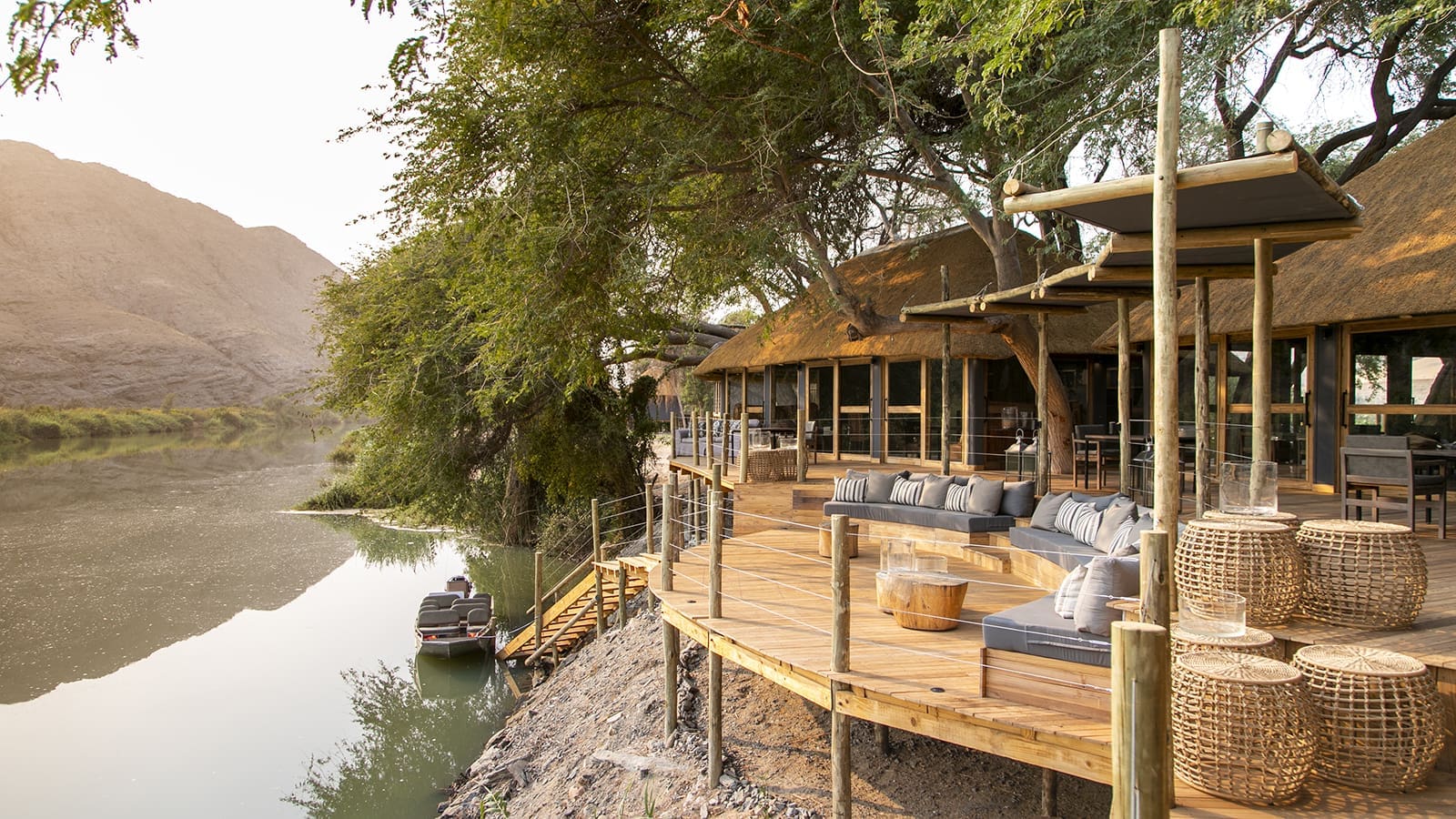

- Location: Kunene River
- # of Rooms: 8 Chalets (Including 1 family unit)
- Available Activities: Game Drives; Night Drives; Scenic Hikes; Pool; Spa; Quad-biking; Visit the Himba; Boating
When people think of Namibia, they usually don’t think of large rivers. Yet, that’s exactly where Serra Cafema is! Situated on the banks of the Kunene River, this intimate, luxurious camp is an excellent base of operations for a wide variety of activities. The decor and aesthetic plays homage to the local Himba people, who own the conservancy that the camp is in.
Etosha National Park
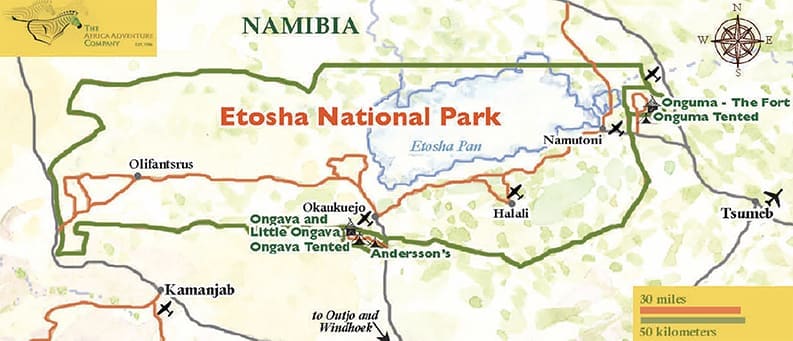

The setting and experience of Etosha National Park and its adjacent private reserves is more like the “traditional” safari experience than any other destination for a Namibia safari.
The Etosha Pan’s dusty plains are the dominating feature of the park, with scatterings of mixed scrub and woodlands. Etosha is well-renowned for its incredibly high concentration and diversity of wildlife. The best time to visit is during the dry season, when wildlife congregate around the remaining waterholes – it’s not unheard of to spot 8 or more different species at a waterhole at the same time!
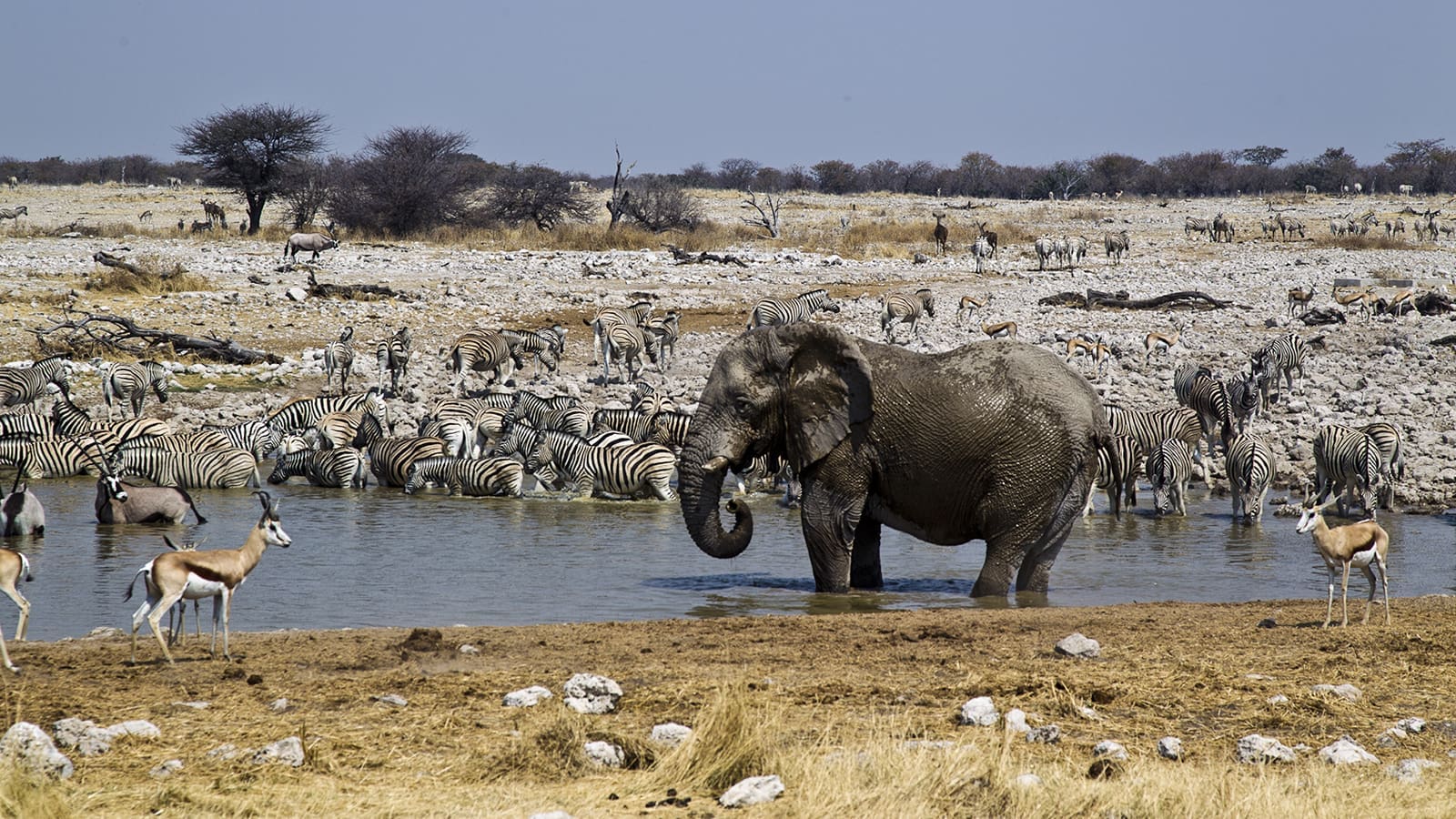

How many species can you identify at this waterhole?
Notable wildlife species include black and white rhino, elephant, lion, zebra, lion, giraffe, leopard and oryx (gemsbok). A major annual event is the arrival of more than a million greater and lesser flamingos during their breeding season.
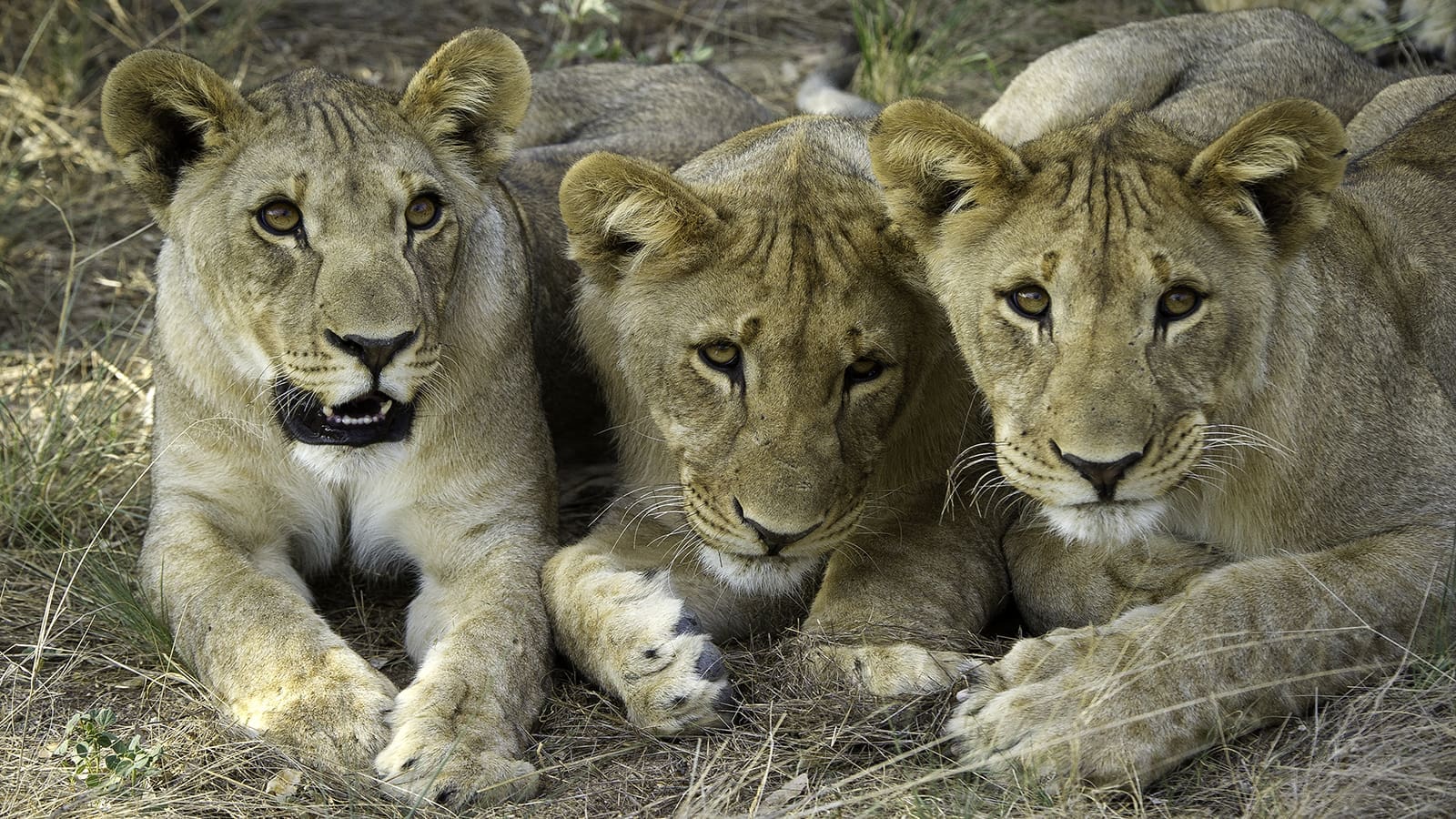

Ongava and Onguma are home to several lion prides, each with entertaining cubs like these!
Waterholes inside Etosha National Park can be crowded, especially during peak season. But the private reserves of Ongava and Onguma have stellar, much more private waterholes of their own.
Guests staying at either of these reserves are also able to go on night drives and guided walks, which is not possible in Etosha. Many of the camps also have photographic hides, commonly situated around waterholes. Even if you’re not an avid photographer, a visit to a hide offers a unique vantage point for game viewing!
Where to Stay: Andersson’s at Ongava
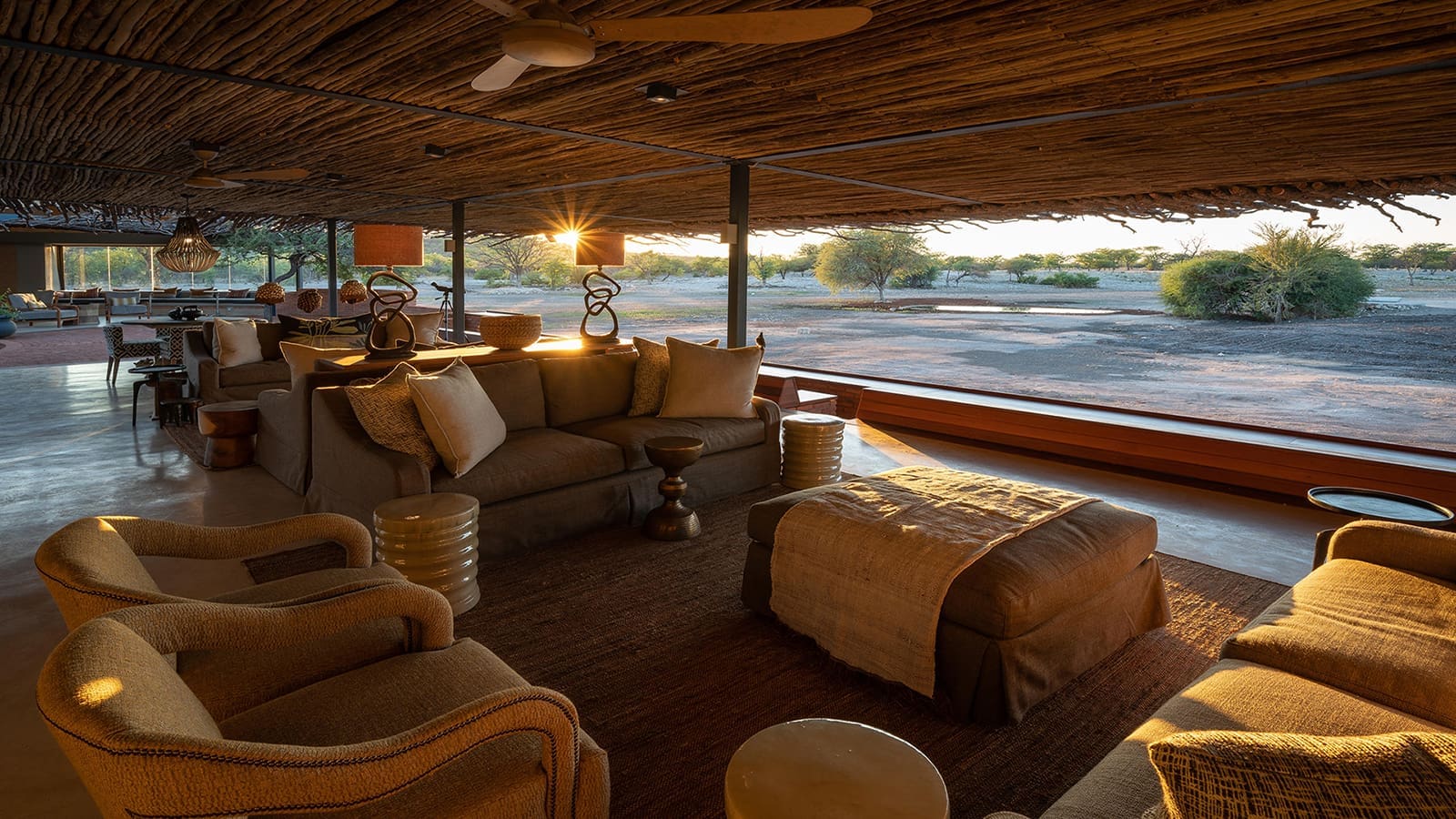

- Location: Ongava Reserve
- # of Rooms: 8 Suites (Including 1 family unit)
- Available Activities: Game Drives; Night Drives; Guided Walks; Pool; Photo Hide; Rhino Walking Safaris; Ongava Research Center; Meet with Researchers and Rhino Security Personnel
Szilvia Hegyi was left very impressed during her stay here last year. No wonder: with 8 spacious, luxurious suites and a superb location next to a waterhole are a wonderful base of operations to explore Ongava and Etosha. And like Hoanib Skeleton Coast Camp, Andersson’s offers the chance to meet with researchers, and even rhino security personnel!
Where to Stay: Little Ongava
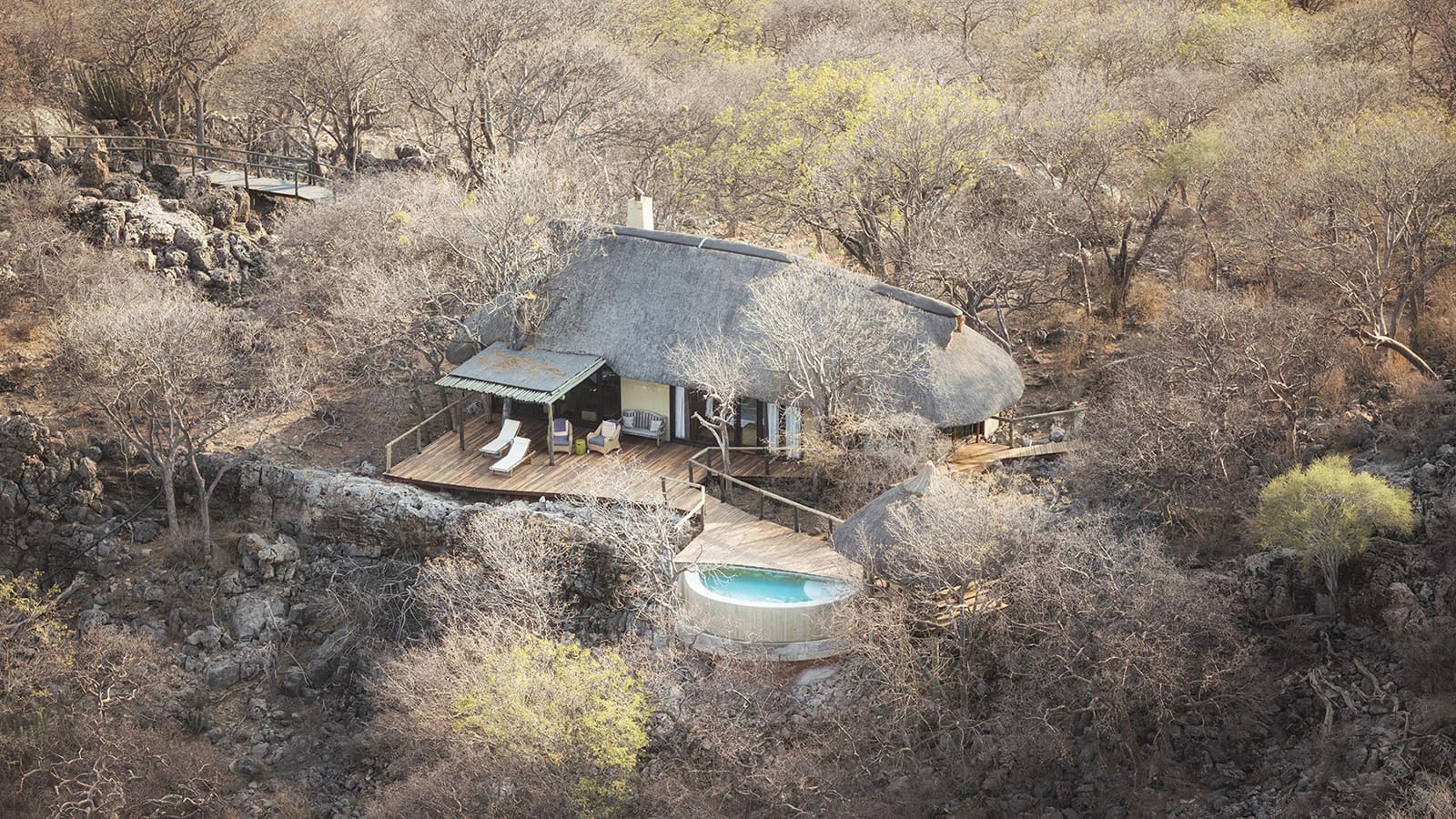

- Location: Ongava Reserve
- # of Rooms: 3 Luxury Villas
- Available Activities: Game Drives; Night Drives; Guided Walks; Plunge Pools; Photo Hide; Rhino Walking Safaris; Meet with Researchers and Rhino Security Personnel
This is one of Namibia’s most refined and exclusive safari camps. Little Ongava’s 3 luxury villas (each with their own plunge pools and bathtubs) and main lounge are perched up on a hill, overlooking an oft-visited waterhole.
Namibian Safari Inspiration
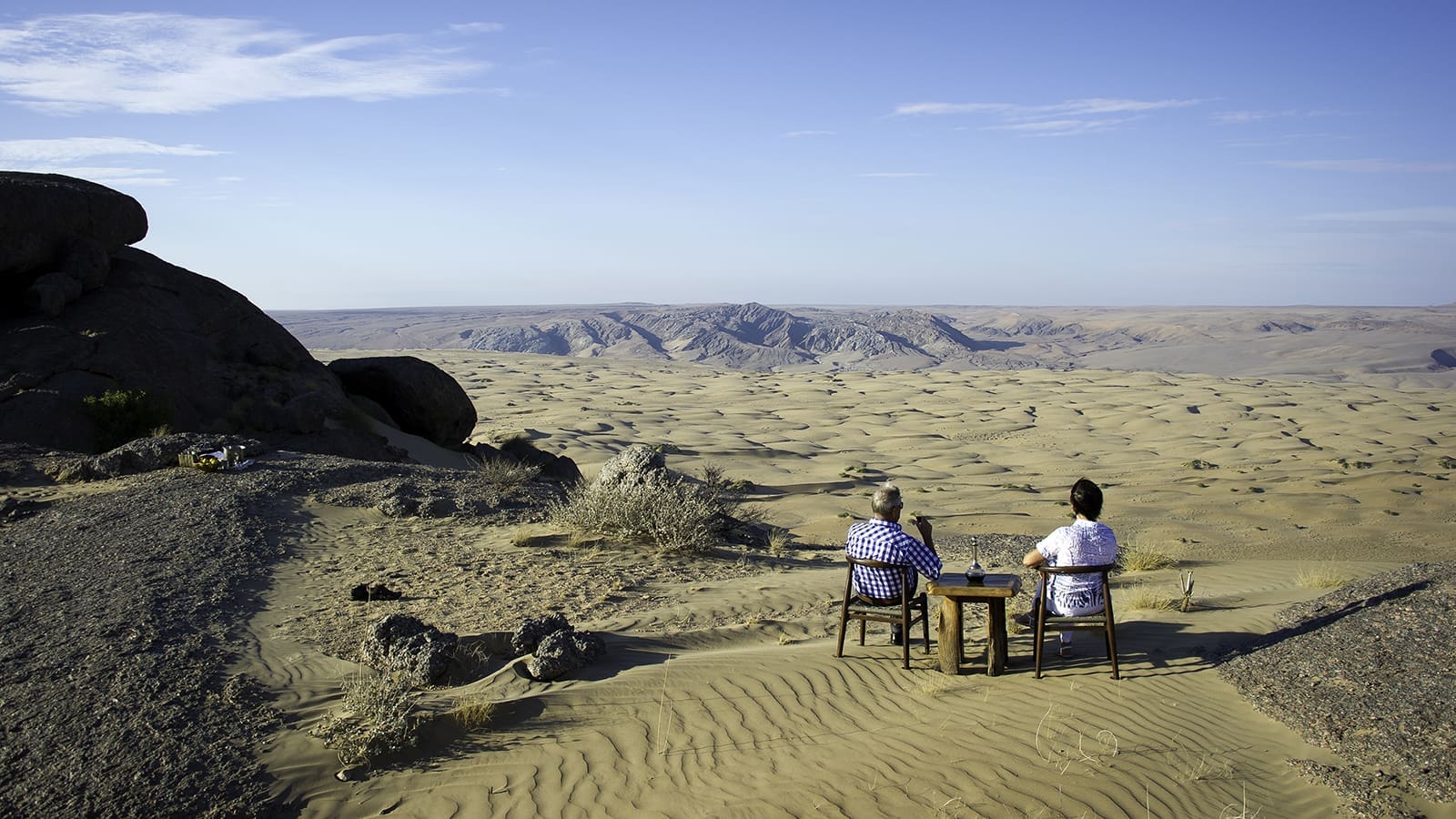

Can you imagine yourself enjoying a drink while enjoying a view like this?
We hope you learned a thing or two about a Namibia safari after reading this. For those of you inspired to plan your own Namibian safari, we have some resources for you. Click this link to see Namibian itineraries on our website:
If you’d like to get in contact with an AAC Safari Consultant about planning a safari to Namibia, we suggest you fill out our safari questionnaire below.

